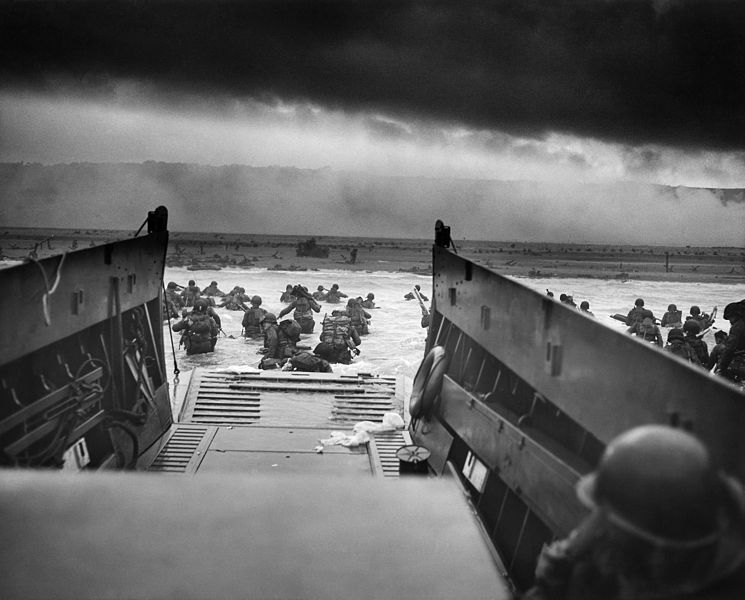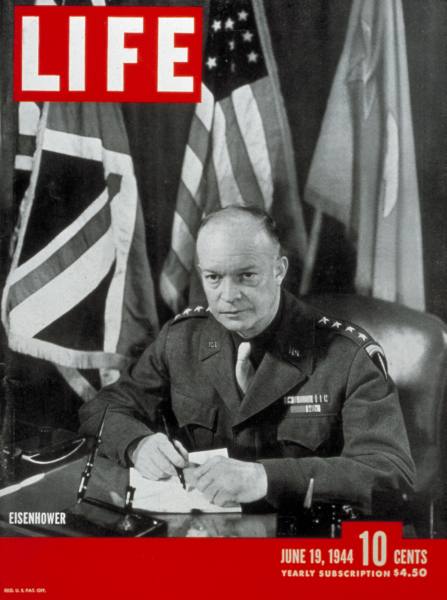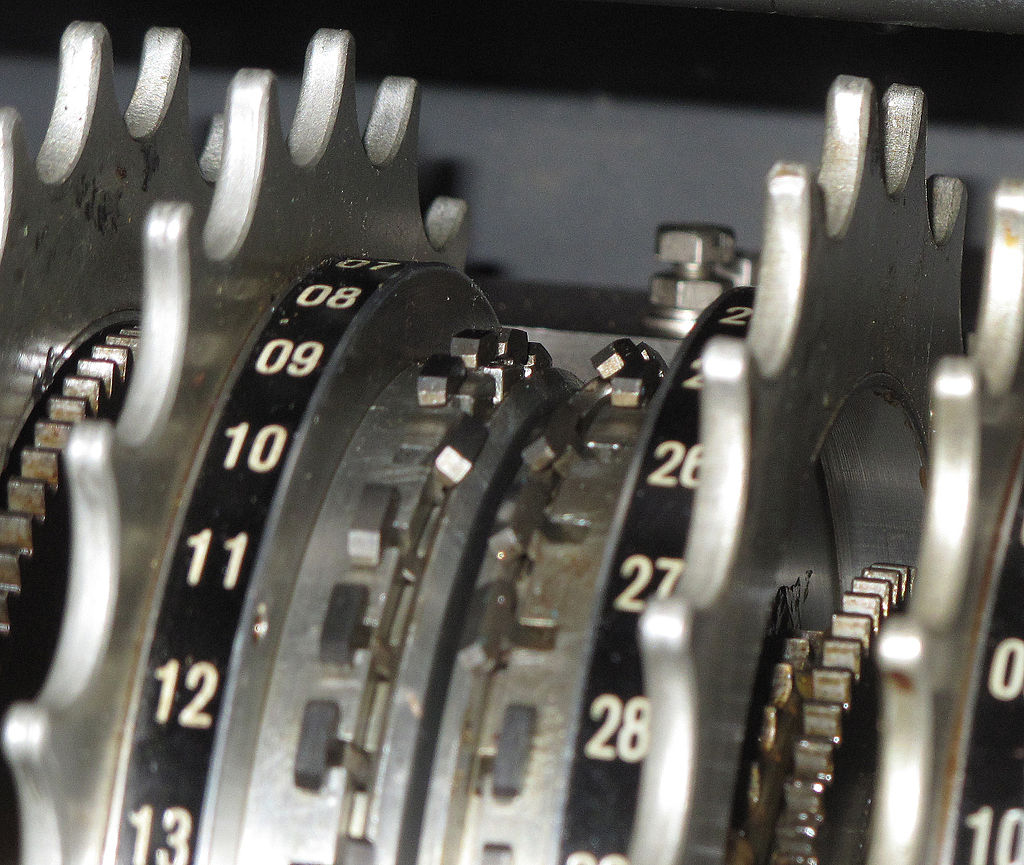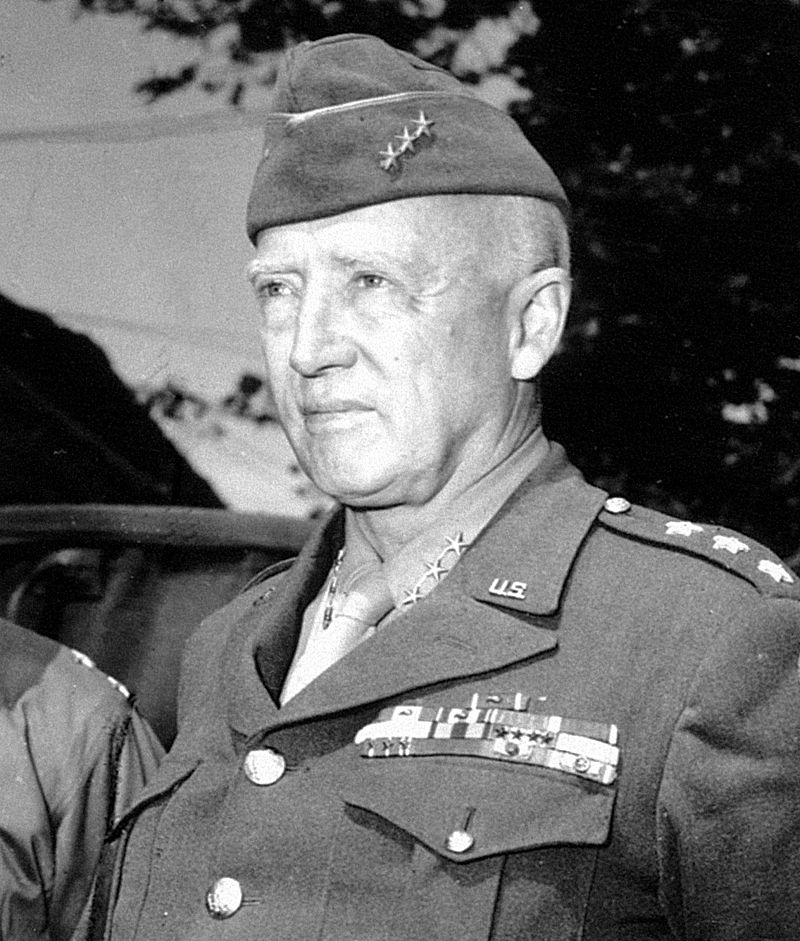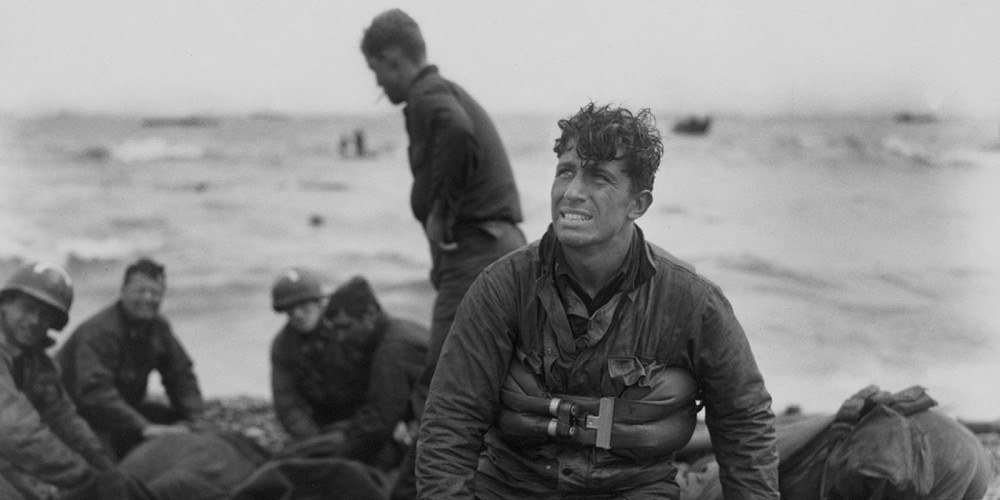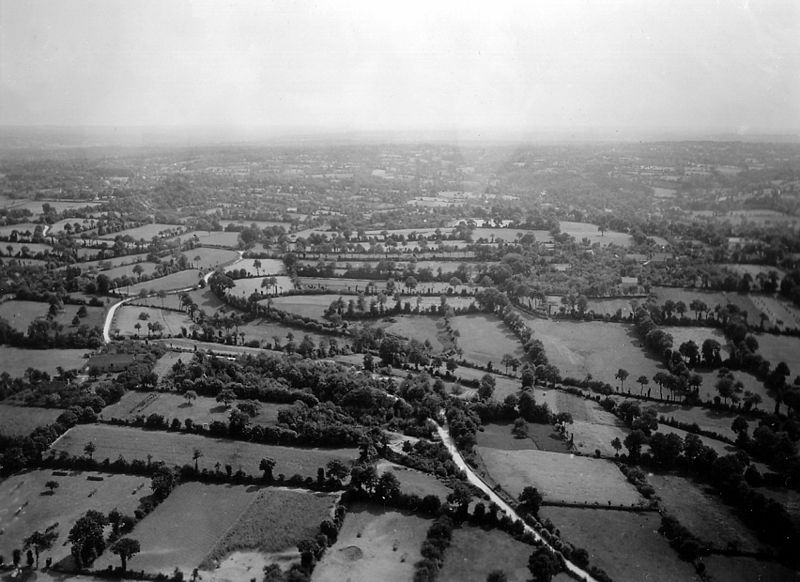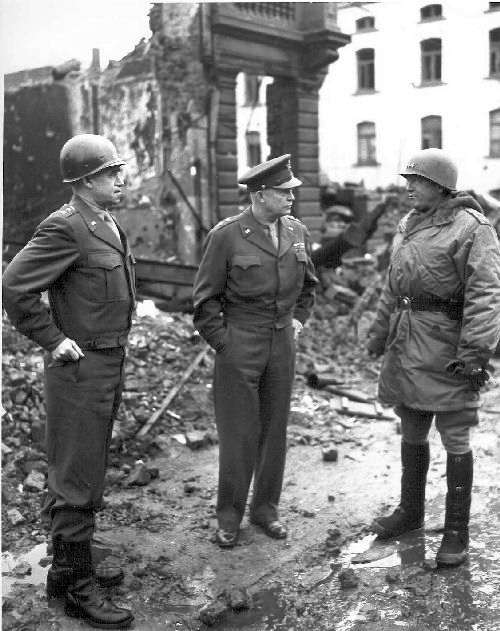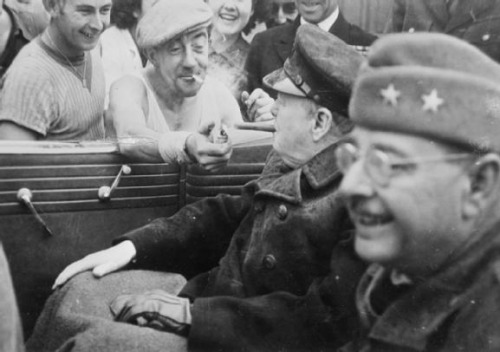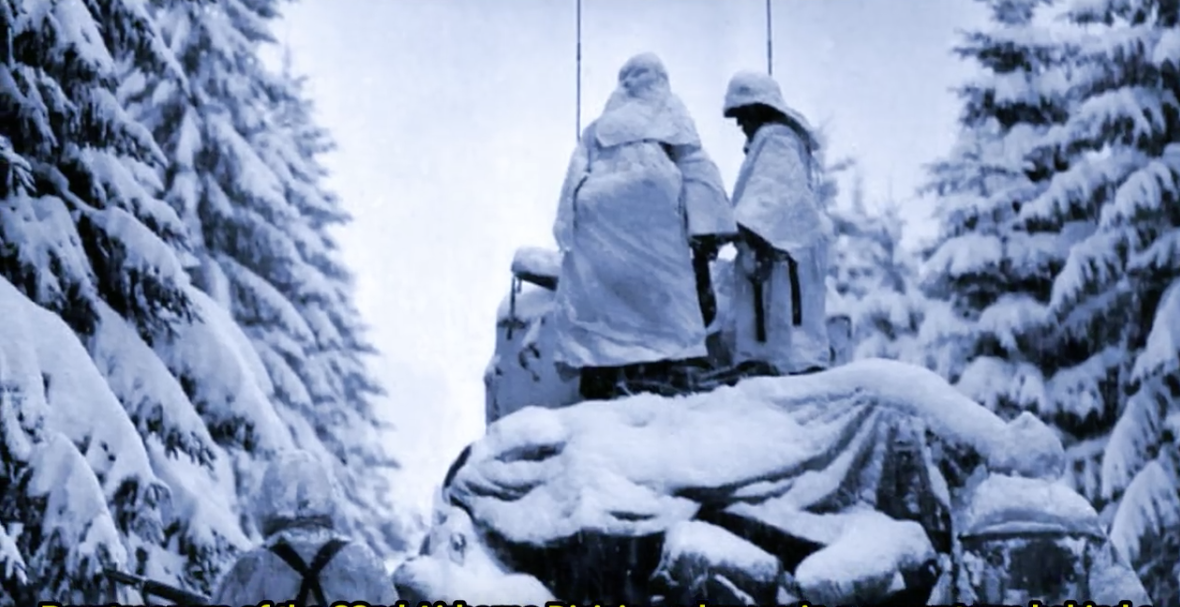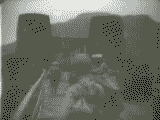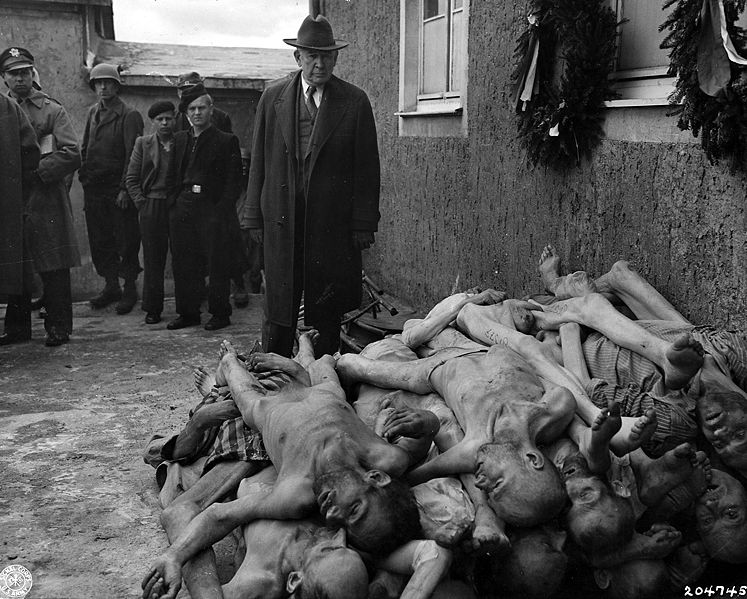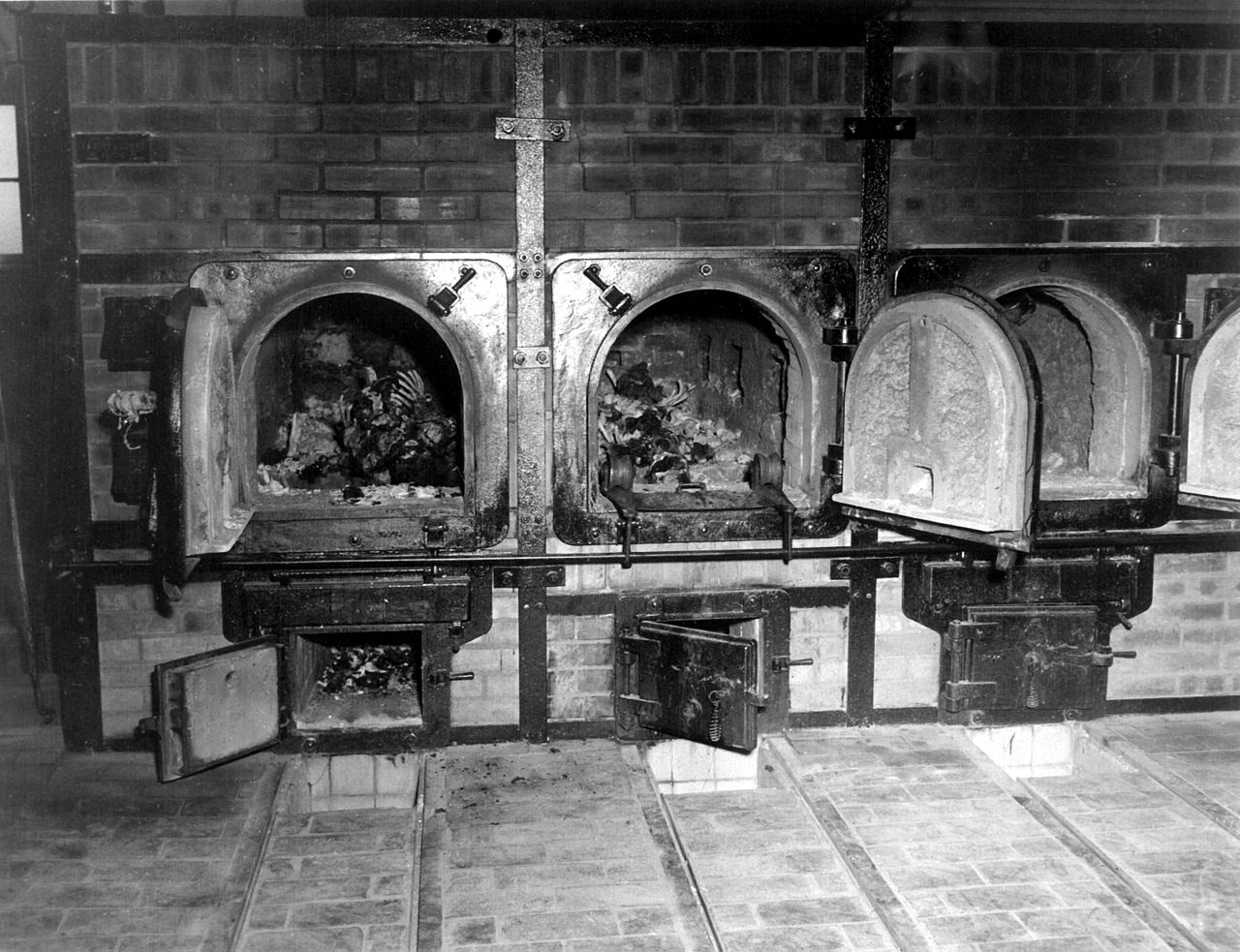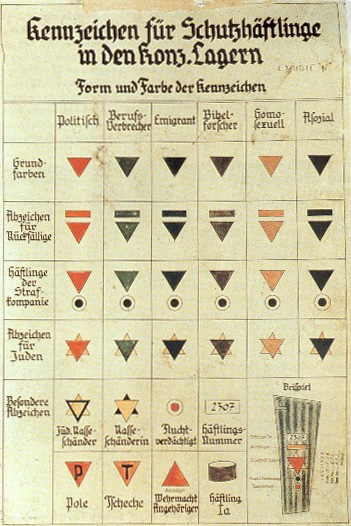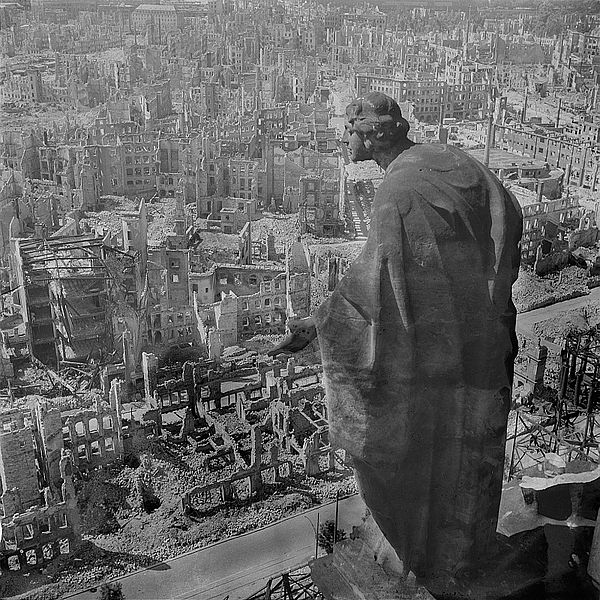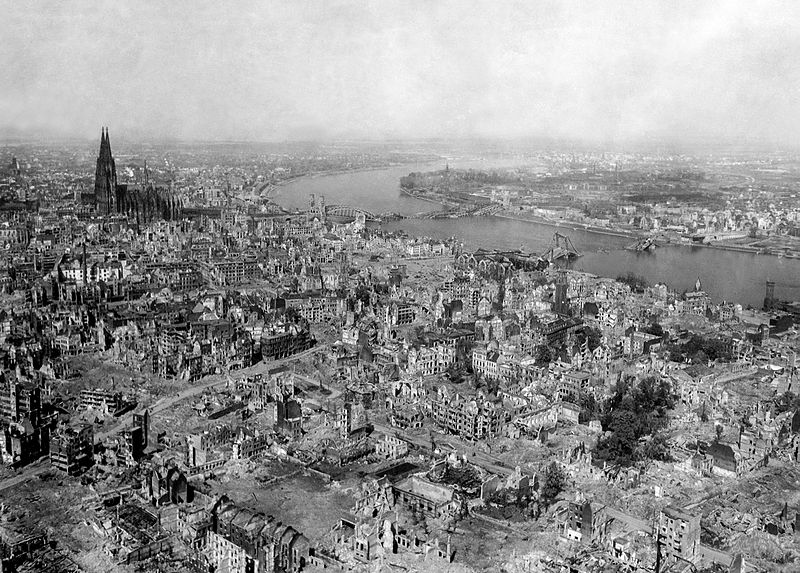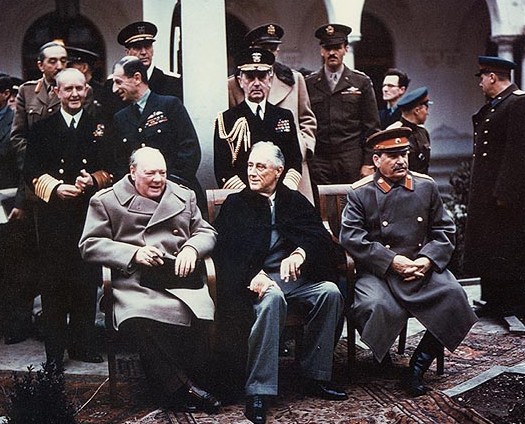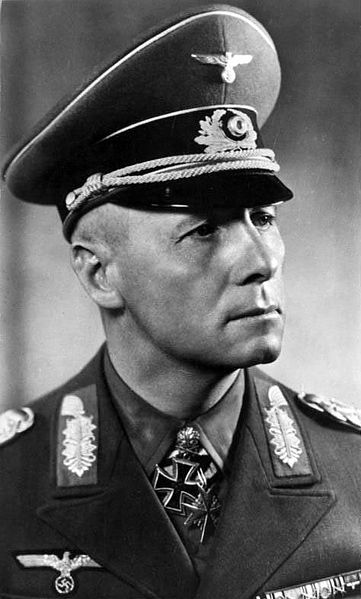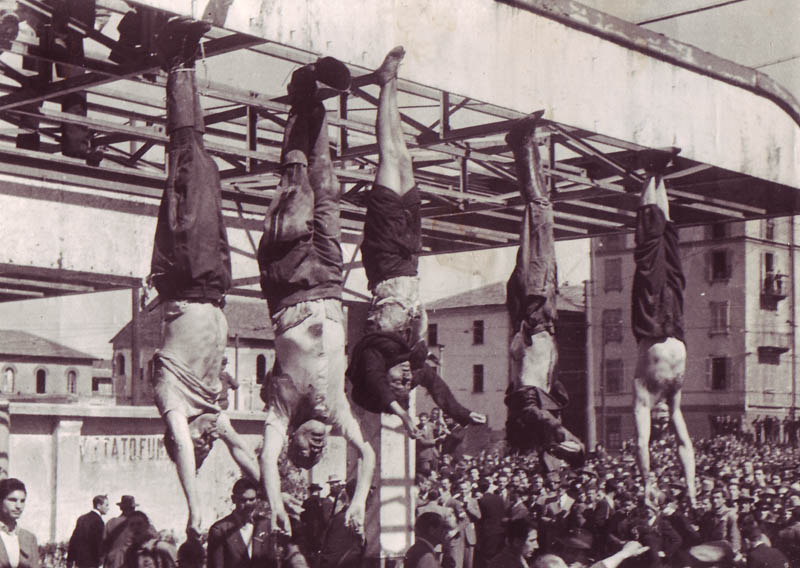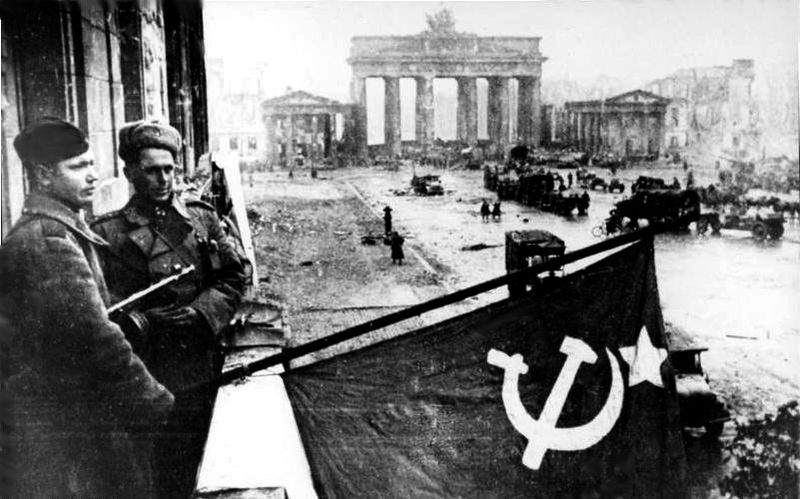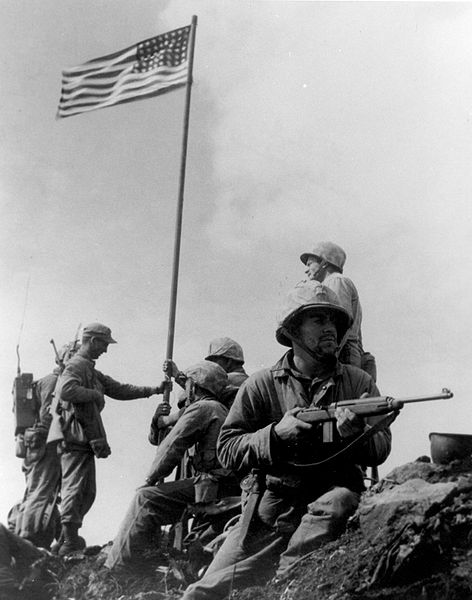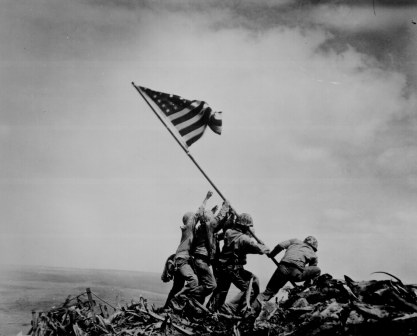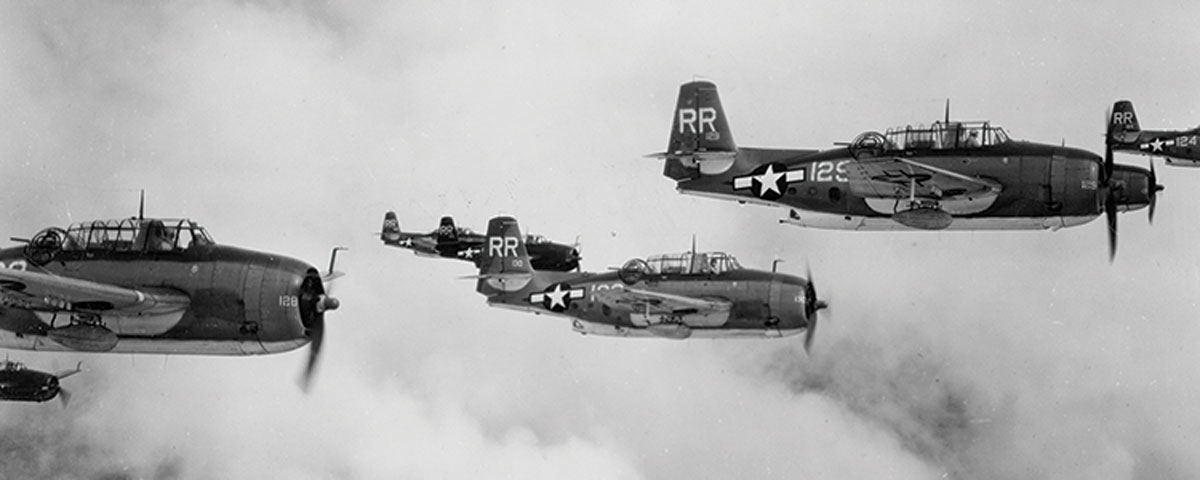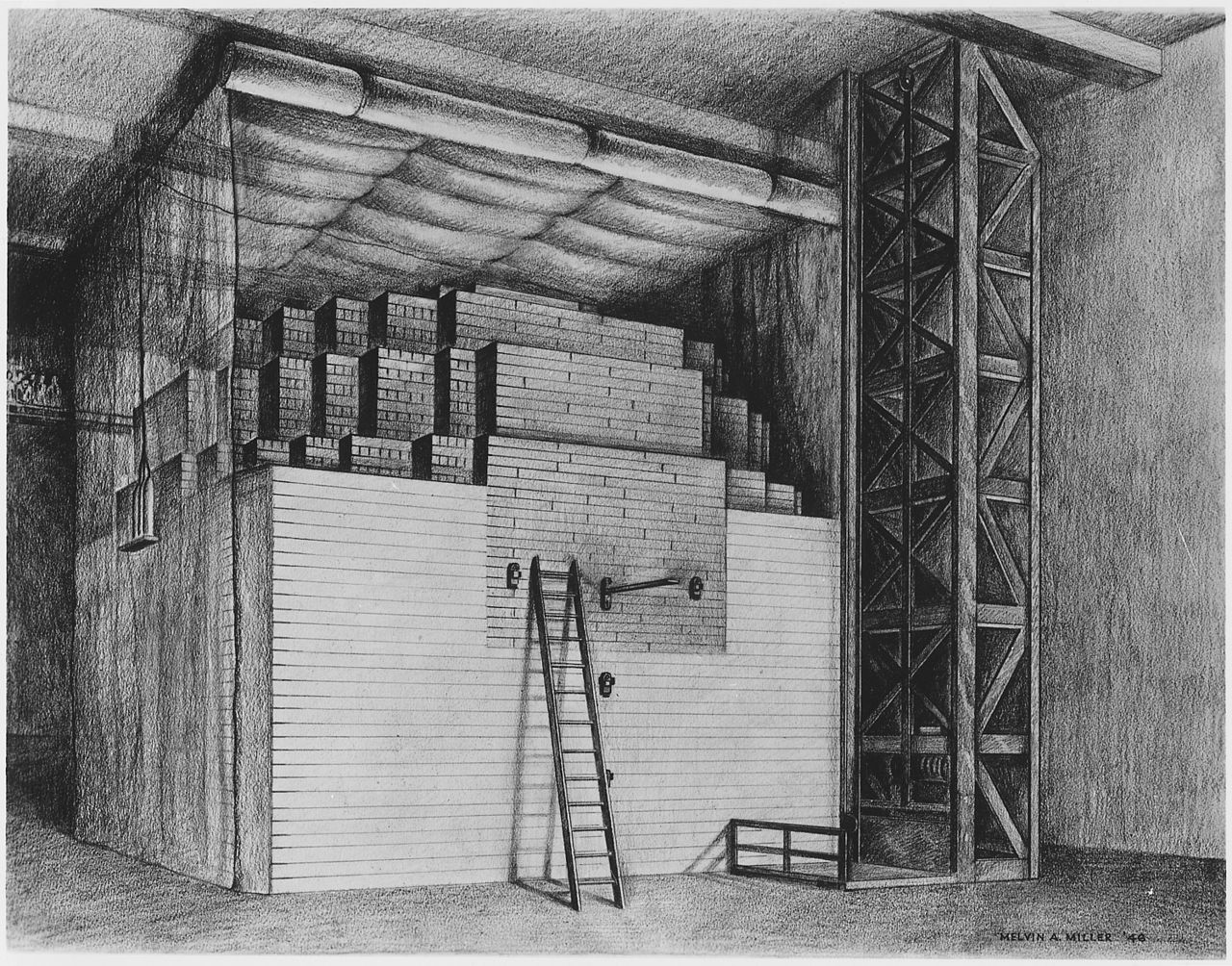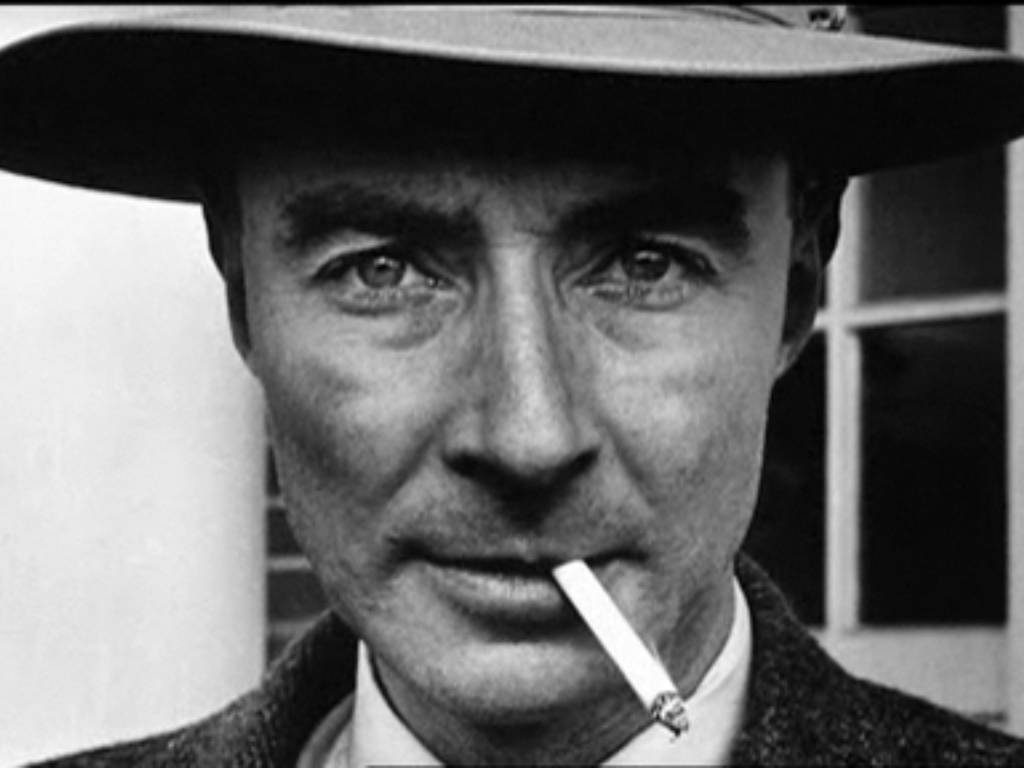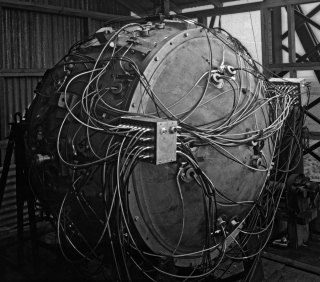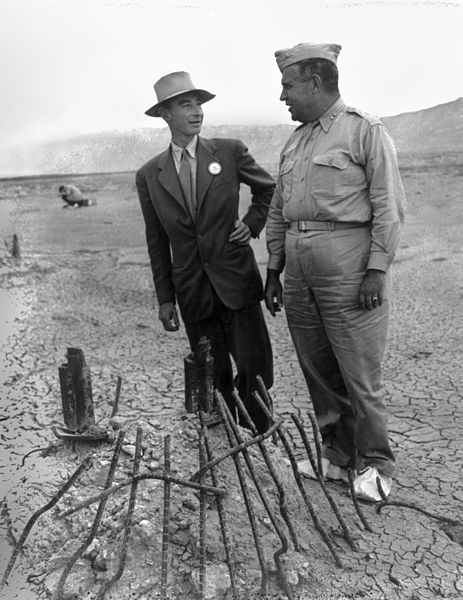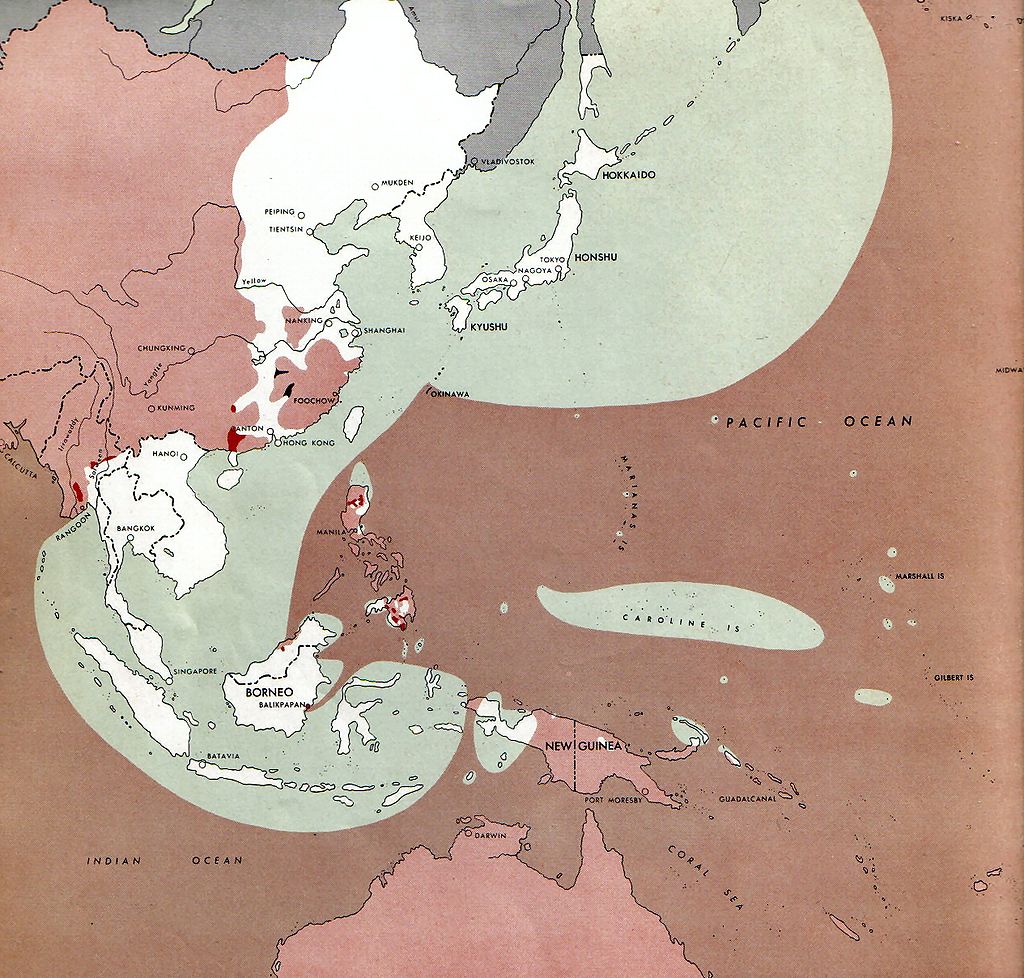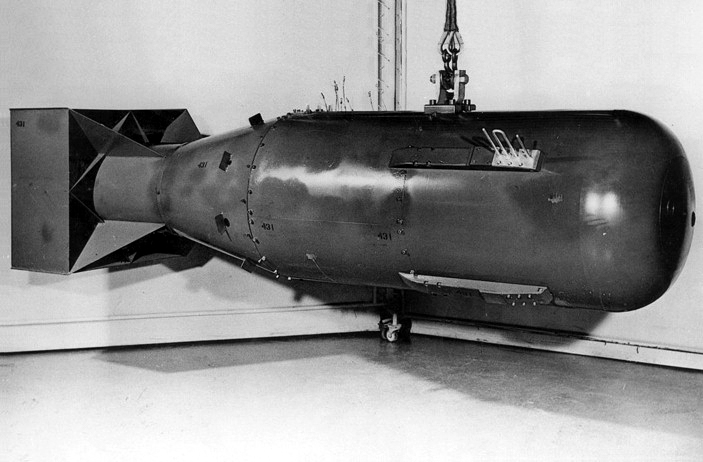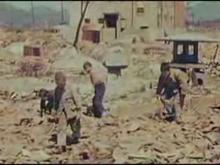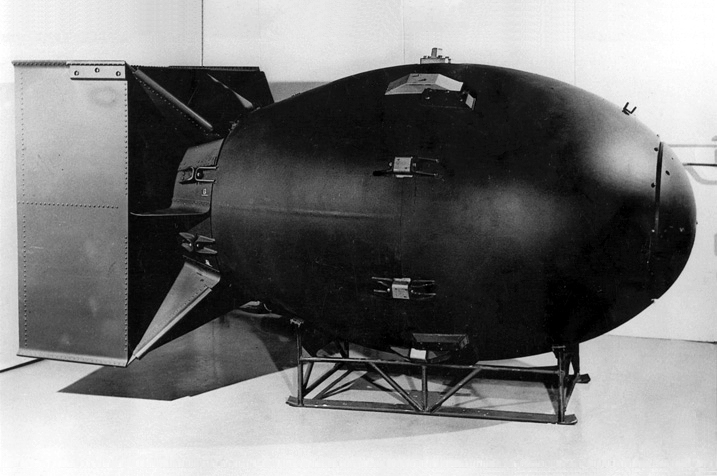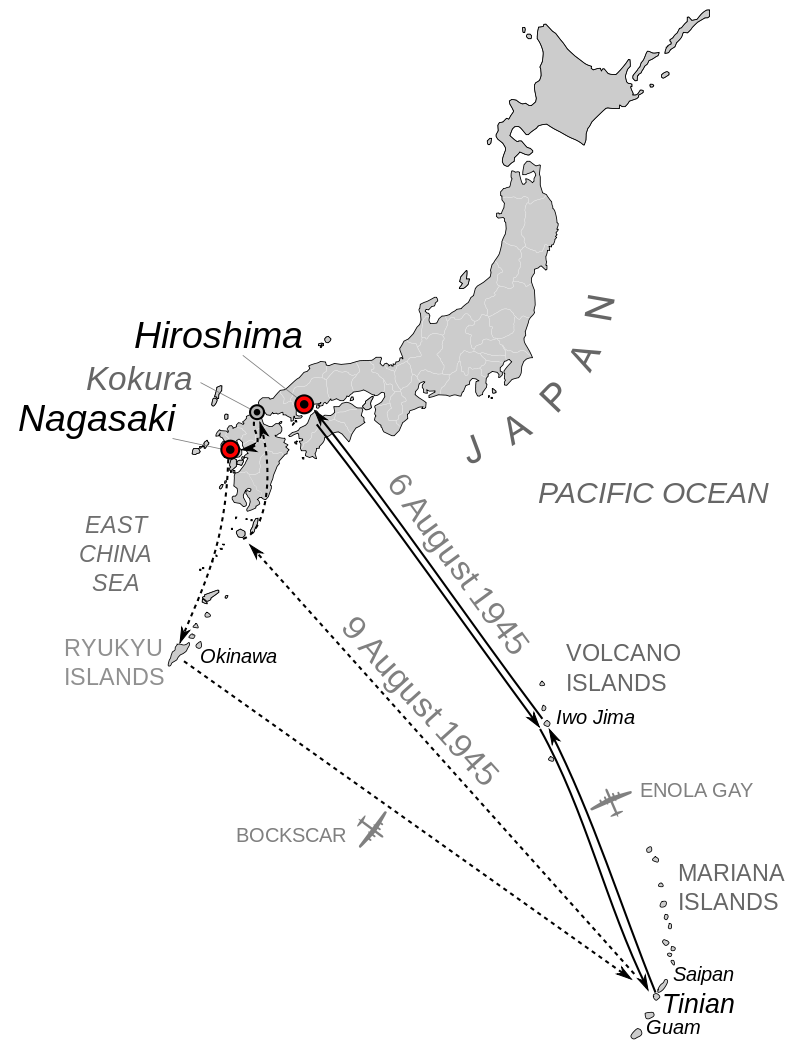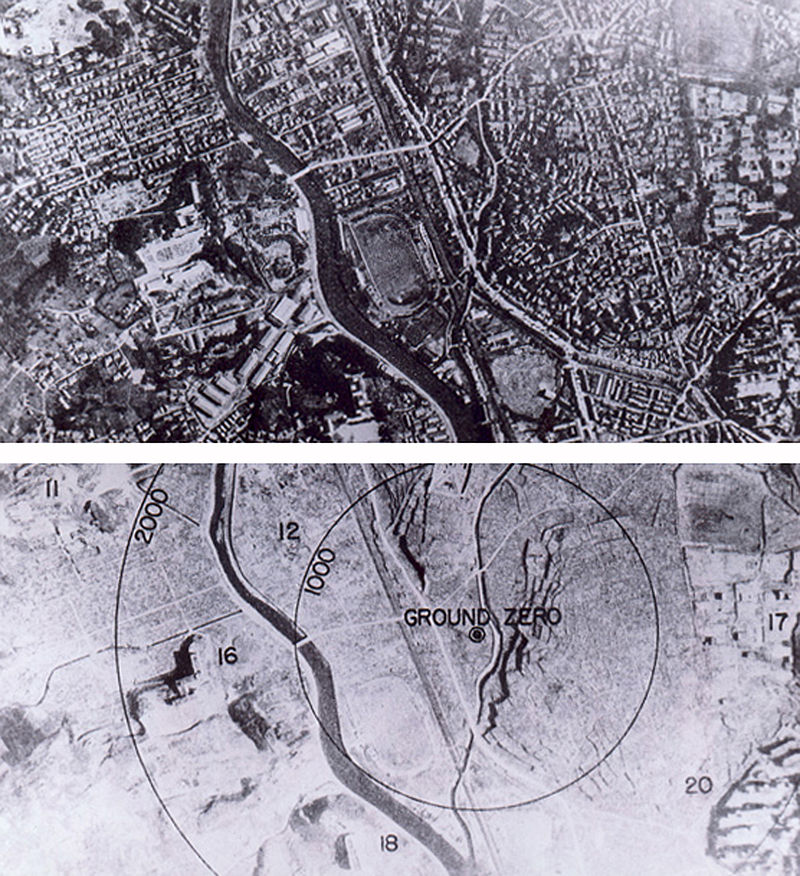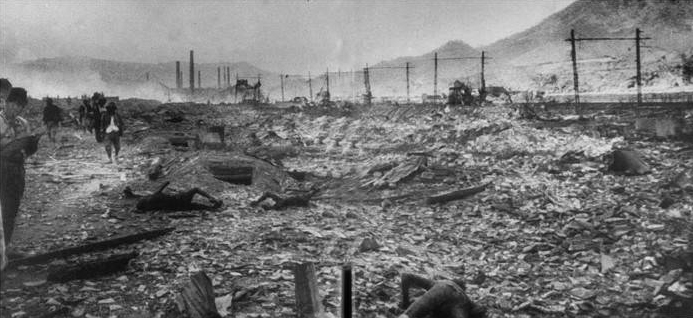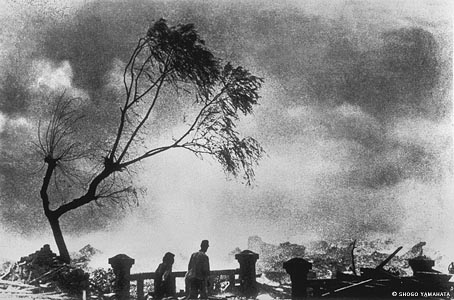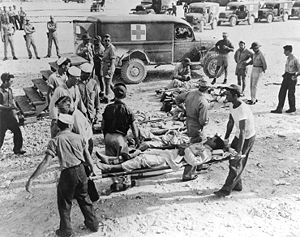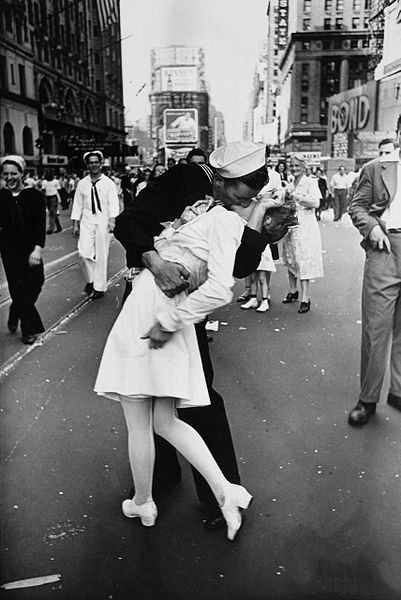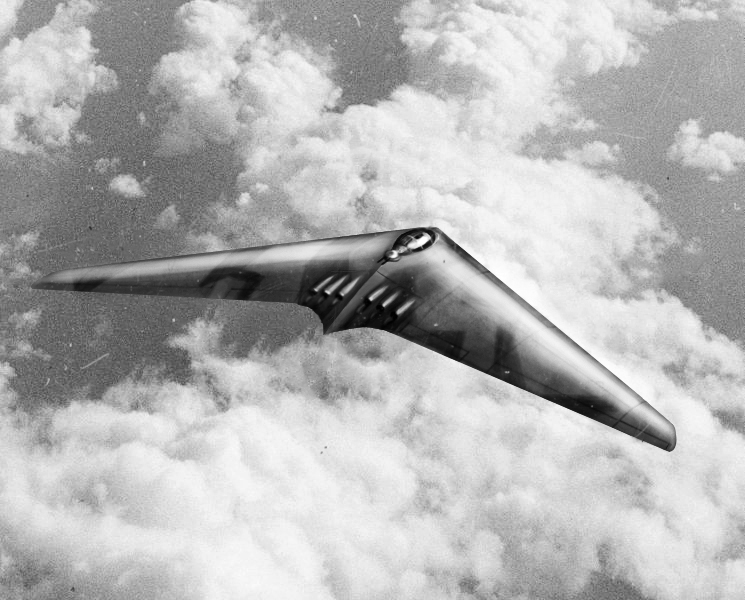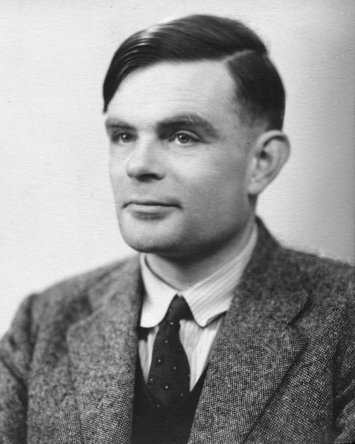“Do not worry if you don’t survive the assault, as we have plenty of backup troops who will just go in over you.” –– British Field Marshal Bernard Montgomery Before Normandy Invasion
By 1944, the U.S. and its allies had swung momentum in their favor, but were still a long way from victory, especially if they defined victory as completely vanquishing Germany and Japan. In the Pacific, the U.S. was almost close enough to run round-trip bombing missions over Japan, while in Europe Soviets were winning a grinding tank war of attrition against the German Wehrmacht across Eastern Europe. The Western Allies, rightfully fearing that the USSR (Soviet Union) would keep whatever it conquered, resolved to invade France and begin their own push toward Germany. Supreme Allied Commander Dwight Eisenhower organized the invasion along with British Field Marshall Bernard Montgomery.
Code Breaking
Espionage and code-breaking are as old as war itself. In 16th-century England, Queen Elizabeth I’s spymaster William Cecil employed Cambridge mathematicians to help him crack the codes of Catholic conspirators trying to overthrow the queen. Earlier yet, in the 6th century BCE, Chinese strategist Sun Tzu wrote in the Art of War that, “All warfare is based on deception.” It was a bit of an overstatement, but misdirection was undoubtedly helpful for the Allies in World War II. To be sure, neither tactical deception nor cloak-and-dagger espionage alone makes the difference. Historian Sir Max Hastings, a chronicler of tradecraft, reminded his readers that, in the end, soldiers, sailors, and airmen ultimately win wars. Yet, we’ve already seen how intelligence and trickery helped the Americans and British at Midway and El Alamein in the previous chapter, helping to turn the war’s tide in 1942. This high-stakes battle of wits continued in 1943-44 as Germany tried to guess where the Allies would launch a land invasion of France from England and both sides raced to develop a nuclear bomb. At the same time, code-breaking helped usher in the computer age. Since phones, telegraphs, and radios were easy to tap or hear, secret codes were essential and breaking codes could give one side a big advantage if the other didn’t know it was broken.
In 1944, the U.S. captured a German U-boat (U-505) off the West African coast that the Kriegsmarine thought they’d successfully scuttled. After attacking it from the air, American sailors boarded the U-505 in time to plug the valves and keep it from sinking. They hauled the giant submarine to Bermuda to reverse-engineer it while Germany assumed it had gone to the bottom of the Atlantic. The U.S. denied the International Red Cross access to the captured crew to keep them a secret. Meanwhile, they gave its code-books, tables, and Enigma ciphering machine to British cryptologists using an early computer at Bletchley Park estate outside London. The British had done likewise with earlier codes captured from the U-110 off Ireland in 1941 and U-559 in the Mediterranean in 1942. While the U-505 story gained traction because of the cipher, these tools were available on the open market between the wars and were well-understood; code-books were more important.
There was no single code to break, but rather multiple codes across various military channels (army, navy and air forces, etc.) reconfigured daily. Breaking these codes could thus provide short-term advantages day-to-day and required a painstaking combination of “cribbing” (educated guesses) and computer aid in trying various combinations. One flaw of German ciphers was that no one letter ever translated into itself, allowing the computers to eliminate that possibility, and cribbers also learned that the Kriegsmarine often started its dispatches from the Atlantic with weather reports, a crucial starting point for code-breaking. Many cribbers were “Wrens,” from WRNS, the Women’s Royal Navy Service.
The Ultra Program at Bletchley was a large-scale collaborative effort that built on the research of Polish mathematicians who’d started trying to break German codes before their 1939 invasion. Alan Turing’s electro-mechanical Bombe helped to break German codes. One key for scaling up computations was using binary (2-digit) code rather than the decimal system like older calculating machines. With 16 four-rotor Enigma-analogues, the U.S. Navy Bombe made by NCR (National Cash Register) in Dayton, Ohio was even stronger than the three-rotor British version. A key figure in applying Boolean algebra (binary code) and digital circuits to telecommunications and computers was cryptographer Claude Shannon, later known as the “father of information theory.” His 1948 paper “A Mathematical Theory of Communication” is considered among the 20th century’s most groundbreaking works.
Along with developing better on-board radar, breaking German codes without their knowledge swung the naval advantage in the Allies’ favor. While Bletchley was only able to break around 15-25% of German messages and sometimes deciphered messages too late, the U.S. still sank most of the U-boat fleet, keeping open vital shipping lanes. With code-breaking and radar, the Western Allies closed the “Atlantic Gap,” the wide swath of ocean that planes couldn’t otherwise reach because of range limitations. Shipping was key, in turn, to saving Britain and preparing for an assault on Germany. The latter would’ve been impossible earlier in the war when the Allies were losing the Battle of the Atlantic to U-boat Wolfpacks.
When Germany figured out that the Allies were deciphering Enigma codes, they built an even harder-to-detect 12-rotor cipher. The Bombe’s successor at Bletchley Park, the Colossus — the world’s first programmable electronic digital computer — amplified binary code on a massive scale to decipher the Enigma’s successor, the 12-rotor Lorenz cipher, and helped launch the digital age. America’s ENIAC (1945) was stronger yet and used for developing the hydrogen bomb. Firmly in control of the Atlantic, with the Wolfpacks at bay, the Allies prepared to invade German-occupied France.
Normandy Landings
To understand the context of the Normandy Invasion, let’s take a quick paragraph to review the big picture from the previous chapter. The timing of the Western Allies opening a western front in World War II wasn’t random. Had they invaded France earlier, they would’ve drawn off German troops from the eastern front unnecessarily, whereas if they’d waited too long, Soviet troops might’ve marched too far west and kept more territory. The former concern is why Stalin was so impatient with the U.S. and Britain to open a western front sooner while Soviets bore the brunt. As for the latter, we saw that Stalin even toyed with the idea of taking France had the Western Allies stood pat. This dynamic is what the (combined) Allies argued about in Tehran in 1943. In 1944, the Soviets were on the move and the Western Allies finally opened a western front, partly to defeat Germany and partly to race the Soviets to Germany. It’s not a huge leap to say that World War II and the Cold War overlapped.
The Allies kept Germany guessing as to where they’d land on the French coast, but their deception came at a price. This was the most famous “D-Day” in history and biggest amphibious assault to date: the Normandy Invasion (Operation Overlord) led by Dwight Eisenhower, in which Allied troops landed along a 50-mile wide swath of beaches in German-occupied northwest France (in the black circle below). British Admiral Sir Bertram Ramsay implemented the detailed plans, including opening two mine-clear paths across the English Channel for the flotilla, blocking the channel’s eastern and western portions, setting up artificial Mulberry Harbors on the French coast, and construction of two oil pipelines across the channel (Operation Pluto). Despite all that, they retained an element of surprise with an elaborate ruse to convince Adolf Hitler that the Allies would attack Norway and cross at a different spot in northwest France than Normandy (operations Fortitude and Bodyguard). 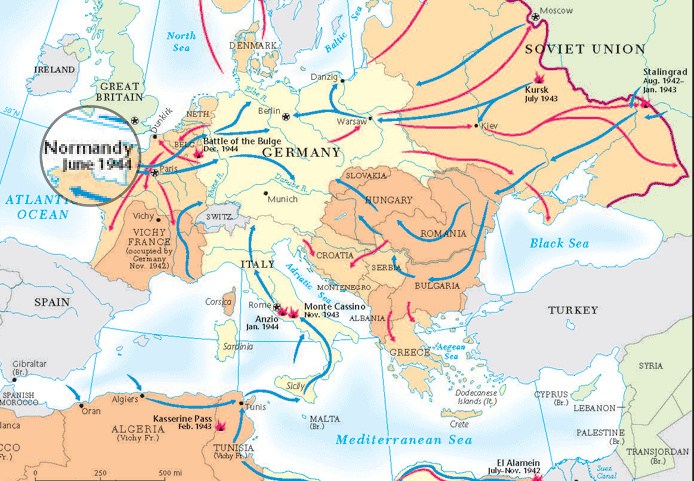
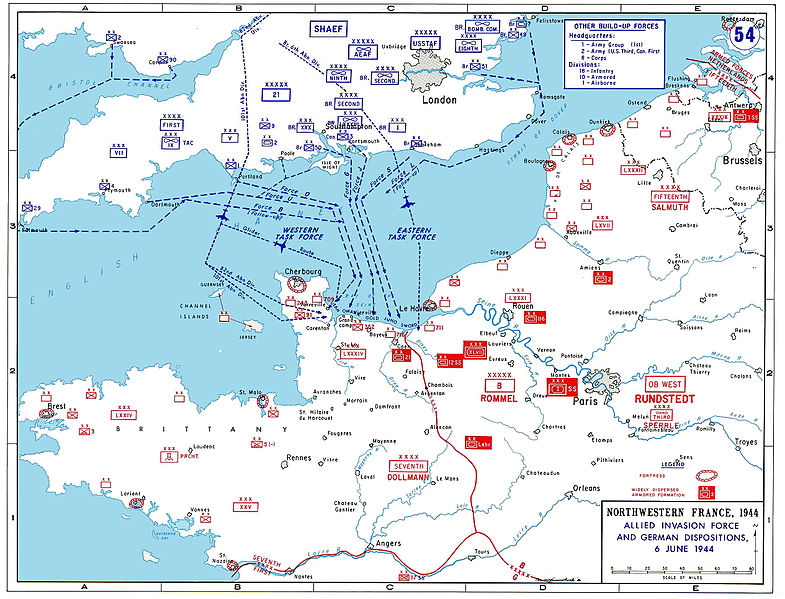
The Allies prepared for months, amassing mock tanks and planes near Dover to fool Germany into thinking they’d cross the English Channel at the narrowest spot, across the Straits of Dover to Pas de Calais. At one point, they feared their secret was out because five of their key code words showed up in the same English crossword puzzle. But they correctly concluded after interrogating the author that it was a coincidence. The Allies also caught a lucky break because of the German-Japanese alliance. Japan’s ambassador to Germany, Hiroshi Ōshima, toured the French coast and radioed home messages with details on German fortifications at Normandy, not realizing that the U.S. had broken a Japanese code with the Purple, or Magic, encryptions (previous chapter).
A network of spies in France carefully and courageously fostered the Calais deception among Nazis. These double agents were on the Nazi Abwehr’s payroll but really worked for the British MI6 passing on fake intelligence to Germany. Most instrumental were Serbian Dušan Popov (aka “the real 007”) and Spanish Civil War veteran Juan Pujol García, who was so convincing that he won an Iron Cross medal from the Germans. While most Nazi officers weren’t fooled by the Calais ruse, the highest-ranking Nazi was. Adolf Hitler took the bait and put his best divisions along the coast near Calais, ready to confront American George Patton, who’d purposely been put in charge of eleven “ghost divisions” near Dover because the Allies knew that the Germans thought he was their best general. Hitler called Patton what translates to that “crazy cowboy general.” Real Allied paratroopers accidentally dropped over Belgium further confused Germany on D-Day.
To prepare for their real landing at Normandy, west of Calais, the Allies dropped paratroopers into France weeks prior to kill Germans and bombed to soften up resistance, killing thousands of French villagers and American paratroopers in the process. Friendly fire, while so controversial today it leads to cover-ups (e.g., the Pat Tillman case in Afghanistan), was routine in WWII, accounting for 12-14% of American deaths. Given how bewildering and chaotic war can be, the high percentage of accidental deaths isn’t surprising, though in this case, they weren’t so much accidental as a calculated write-off. Allied bombers also inadvertently killed ~ 70k French civilians, thousands of whom were no doubt part of the French resistance against Germany (Wikipedia). The French Resistance and British special forces (SOEs, aka the “Ministry of Ungentlemanly Warfare”) sabotaged German forces as the Normandy Invasion unfolded to slow their response. As intended, Hitler saw the bombings and initial Normandy landings as a diversionary tactic intended to trick him into moving his main forces from Calais, and he kept them there based on Juan Pujol’s word. Pujol then faked his own death and escaped to Venezuela.
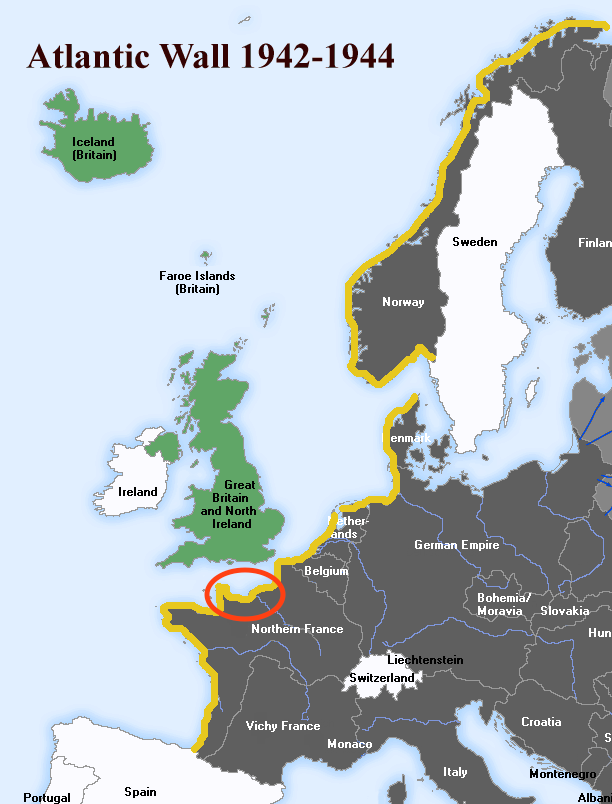 Eisenhower timed the invasion with a full moon and half-tide but that only provided a narrow three-day window between June 5th and 7th, 1944. On June 6th, a massive flotilla carrying 140k Allied troops hit beaches across northwest France, while a smaller force invaded Provence in southern France with Operation Dragoon, the ultimate goal being to squeeze German forces in a pincer. In the north, the Navy started bombing the German Atlantic Wall along the shore at 3:15 am and failed to inflict much damage, but the Allies decided against calling off the invasion because some troops had already landed on the beach and it was too late to turn back. Stateside, FDR used a radio fireside chat to lead what was probably the biggest mass prayer in history. More paratroopers landed just behind the Atlantic Wall June 5th-6th, including the subjects of Stephen Ambrose’s Band of Brothers (1992, HBO 2001), the “Easy Company” 506th Parachute Infantry Regiment of the 101st Airborne Division. German Fallschirmjäger pioneered airborne invasions on Crete in 1941 but met stiff civilian resistance. However, the Allies employed the strategy effectively enough at Normandy that West Point cadets still study the Easy Company’s capture of the German battery in their Brécourt Manor Assault.
Eisenhower timed the invasion with a full moon and half-tide but that only provided a narrow three-day window between June 5th and 7th, 1944. On June 6th, a massive flotilla carrying 140k Allied troops hit beaches across northwest France, while a smaller force invaded Provence in southern France with Operation Dragoon, the ultimate goal being to squeeze German forces in a pincer. In the north, the Navy started bombing the German Atlantic Wall along the shore at 3:15 am and failed to inflict much damage, but the Allies decided against calling off the invasion because some troops had already landed on the beach and it was too late to turn back. Stateside, FDR used a radio fireside chat to lead what was probably the biggest mass prayer in history. More paratroopers landed just behind the Atlantic Wall June 5th-6th, including the subjects of Stephen Ambrose’s Band of Brothers (1992, HBO 2001), the “Easy Company” 506th Parachute Infantry Regiment of the 101st Airborne Division. German Fallschirmjäger pioneered airborne invasions on Crete in 1941 but met stiff civilian resistance. However, the Allies employed the strategy effectively enough at Normandy that West Point cadets still study the Easy Company’s capture of the German battery in their Brécourt Manor Assault.
Operation Crossbow (previous chapter) had mostly crippled Germany’s V-1 program; otherwise, the rockets could’ve stopped the flotilla as it crossed the channel. Animated Map Some troops were lucky and landed on undefended beaches. Others popped out of Higgins boats like Marines in the Pacific into a buzzsaw of incoming fire from Nazi bunkers. They could hear the bullets raining down on the boat’s hatch even before they opened it (given tides and the distance around the craft, it was still easier to offload in the front than back). For many, like those at Omaha Beach, Normandy was a near-suicidal sacrifice. If they managed to make it off the boat, they had to wade to shore and make it across hundreds of yards of mined beach and barbed wire. Resistance varied because Germans struggled to get their equipment to the shore at certain beaches and some of their troops were less dedicated because they were actually Osttroopen: Soviet POWs who chose to fight rather than be killed or stay in the camps. It’s hard to imagine the POWs really opposing Germany’s downfall even if they had to fake a reasonable effort to stay alive.
Survivors worked their way up the cliffs and around the bunkers to clear out Germans, giving the Western Allies a foothold on continental Europe they hadn’t had since the British fled Dunkirk in 1940. Memorials and get-togethers commemorate their heroics to this day. The Allies paid a price for their deception, though. By landing at Normandy, they were further away from Germany than they would’ve been had they crossed between Dover and Calais. Of Americans that died in WWII, ~75% died in Europe and 25% in the Pacific. Of those that died in Europe, most died between D-Day and Germany’s surrender a year later. Their story has been told in numerous books and films, including Cornelius Ryan’s The Longest Day (1959, 1962 Film), A Bridge Too Far (1977), and Saving Private Ryan (1998), along with Band of Brothers. For those interested in primary source color footage from 1944-45 (16 & 35mm Kodachrome), see George Stevens’ documentary D-Day to Berlin at the bottom of the chapter, which includes Normandy, Paris’ liberation, Battle of the Bulge, and discovery of the Dachau concentration camp.
Hedgerow-to-Hedgerow
A daunting challenge confronted the British, Polish, Free French, Canadians, and Americans led by Omar Bradley, Courtney Hodges’ 1st Army and George “Blood & Guts” Patton’s 3rd Army: a tortuous “hedgerow-to-hedgerow” crawl across the countryside, so named because of the shrub-lined roads and fields of France’s Bocage region. There were numerous German counter-offensives within this seemingly bucolic landscape. Allied intelligence saw the hedges in aerial photos but assumed they were only four or five feet tall, not twenty or more. They blocked tanks and were impossible to climb, constituting a maze filled with Nazi snipers and ambushers. The Western Allies found themselves in the same rattenkrieg (rat warfare) the Soviets experienced in Stalingrad a year-and-a-half earlier. Hand-to-hand combat was common as the Allies cleared Germans from barns, groves, and villages. Future comedian Mel Brooks was a combat engineer charged with securing the houses German troops had been living in. Most were booby-trapped to explode if someone turned a door knob or flushed the toilet and surrounded by mines defused by probing the dirt with bayonets at 45º angles. Anthony Benedetto, future singer Tony Bennett, described fighting in France and Germany as a “front row seat to Hell” and became a pacifist after the war. In Europe, the Army stripped him of his corporal stripes when he was caught eating dinner with a black friend, an experience that later inspired Bennett to lend celebrity support to the civil rights movement.
While the initial Normandy invasion was successful, the Allies suffered several defeats in northern France and the Low Countries in the summer of 1944 before making significant headway. Meanwhile, the Germans’ improved V-2 Rockets terrorized Londoners. Animated Map Germany also had the biggest tanks, but the nimbler American M4 Shermans could gang up on German Tigers and attack them before they swiveled their long turrets to most of the Shermans. Tanks came of age toward the end of WWI as a way to break the trench stalemate and Eisenhower and Patton both specialized in tank warfare between the wars. Patton led the first-ever American tank offensive toward the end of WWI at Saint-Mihiel (Patton also fought against Pancho Villa in Mexico before WWI). Tanks were in the North African desert, Russia, and France. In France, many Sherman Tanks even had a special clipper mounted on the front to help them plow through hedgerows.
Eventually, Patton’s tank regiments built up enough momentum that they outran their own supply lines, making it difficult to capitalize on their gains as Hitler sent more forces west from the Eastern Front. Hitler’s officers were skeptical of diverting too many forces from Russia to try to stop the Western Allies, but few questioned Der Führer much directly after the failed coup against him that summer. He purged his officer corps after some tried to assassinate him inside his “Wolf’s Lair” headquarters in East Prussia on July 20th. However, Germany was now caught in a pincer. When Nazis diverted troops to deny the Western Allies access to the port at Antwerp, Belgium, that only made things easier for the Soviets as they rolled into eastern Germany toward Berlin, clearing out concentration camps and filling them with their own prisoners along the way. By August, the Western Allies liberated Paris and Rouen, Verdun, Brussels, and Antwerp fell shortly thereafter. Eisenhower gave Charles de Gaulle the honor of leading Free French forces into Paris first, followed by the Americans and UK troops. German General Dietrich von Choltitz disobeyed Hitlers’ order to burn Paris in retreat, as retold in Collins and Lapierre’s riveting Is Paris Burning? (1965). He saved the iconic tower that Gustave Eiffel designed as sturdy but easy to disassemble.
Battle of the Bulge
The Allies hoped they’d end the war by Christmas 1944, but the going got tougher as they approached the German border and Hitler transferred elite forces from the Eastern to Western front for the Ardennes (Forest) Counteroffensive. First, an Allied Rhine Valley airborne invasion called Operation Market Garden failed in its objective to capture the number of bridges needed to cross into Germany. Second, Hitler pushed back against the least experienced American lines in eastern Belgium and northern Luxembourg. It was a 44-day counterpunch known as the Battle of the Bulge, intended to divide British and American troops and trap Allied armies in Belgium as the Wehrmacht captured Antwerp and drove them back to the English Channel (LC Interactive Essay).
Retreating American troops blew up their own fuel dumps to stall the Ardennes Counteroffensive, realizing the German plan would fail without fuel. Everyone in the military including desk clerks goes through basic training and the Battle of the Bulge is a good example of why. Clerks took up arms and, four years before official integration, black and white troops fought alongside each other for the first time in American history. Two factors turned the tide in the Allies favor: destroying their fuel paid off and clearer weather allowed bombers to target the stalled Germans.
The Allies prevailed in the Ardennes “meat grinder” and made their way into Germany, repairing torn up bridges and railroad tracks as they went, and encountering young and old soldiers as Germany ran out of fighting-age troops. The Allies fought there for the intact Ludendorff Bridge, using it to cross tanks and supplies for ten days before it collapsed (killing 28), all the while drawing off Germans from other parts of the line who were trying to destroy it. Journalist Andy Rooney, later famous on 60 Minutes, reported the scene, describing how the Germans used bombardment, frogmen, and V-2 rockets to take down the bridge. The concussion from V-2’s finally shook it down.
Holocaust
American and British forces came across their first concentration camps as they made their way into Germany, along with the underground Jewish slave rocket factory at Mittelbau-Dora near Nordhausen that made V-2 rockets and Messerschmidt interceptor jets. Leaders were aware of the camps and neither FDR nor Winston Churchill seemed overly concerned about them in their letters, but they were a shock to the military. Roosevelt learned about the camps in 1942. To his credit, FDR established the War Refugee Board in January 1944 to aid survivors, but historians disagree on how complicit the president was in restricting immigration and information prior to then. Some (e.g., David Wyman) argue that FDR didn’t want to show mercy toward Jews because he thought it would cost the Democrats anti-Semitic votes and Jews were already supporting the New Deal anyway, denying them electoral leverage. Others (e.g., Michael Berenbaum) stress that the State Department was blocking immigration and news without FDR’s knowledge and that he promptly established the War Refugee Board when he found out. The Soviets discovered their first camps in the East in 1944 and reported them, but many Westerners thought they were exaggerating, as warring countries often do to demonize their opponents. Britain, for instance, went overboard in their descriptions of German atrocities in Belgium during WWI.
The Holocaust (or Shoah in Hebrew and drawn from the Greek holokaustos; translates to catastrophe) was the most depressing aspect of WWII and modern history in general. While more civilians might have died in Stalinist Russia than the Holocaust, the Nazis reveled in the slaughter and torture in a more perverse way, exploring the bounds of evil. Some captives at the Mauthausen camp in Austria were forced to carry boulders up and down hills all day. Friends were forced to push each other off quarry cliffs. Not only were prisoners forced to kill each other, but they left corpses strewn around the living. At some camps, prisoners were forced to bury the dead. A recently discovered diary of SS Director Heinrich Himmler reveals him ordering mass killings while getting a massage and feasting at a banquet just after watching hundreds of women and girls getting gassed to death. Himmler described the eradication of Jews as an unpleasant but noble job, comparing it to descending into sewers to kill rats.
Polish prisoners at the Auschwitz slave and extermination camp were thrown into the snow so doctors could measure the rate at which people froze to death. Jews had to buy tickets for the trains that took them to the death camps, where millions were gassed, worked to death, and used for medical experiments. Nazis made lamps and other artifacts out of Jewish hair and skin. They obsessively inventoried hair, shoes, teeth, glasses, ash, and children’s toys in adjacent warehouses. Hitler filled his own teeth with gold from prisoners’ fillings. Some prisoners were subjected to medical experiments, most famously those led by Josef Mengele (the “Angel of Death”) at Auschwitz, who escaped to South America after the war. Auschwitz claimed more victims (1.1 million) than the combined British and American soldiers killed in WWII. Next worst after Auschwitz was Treblinka, an extermination camp in Poland masquerading as a train station.
Nazis wiped out most of Europe’s Jewish population, slaughtering at least six million Jews and another three million homosexuals, Gypsies (Romani), dissident intellectuals, leftist politicians, and theologians, Freemasons, people with disabilities, Poles, Soviet POWs, Jehovah’s Witnesses, and “Swing Kids,” or Swingjugend — German youth enamored with the West, especially the sounds and styles of black-inspired American jazz (Holocaust Victims). Each category had a special symbol and color, as shown in the chart below. Gays were pink, for instance, while Polish citizens were red. The Wehrmacht (regular army) shared responsibility with the SS for carrying out the “liquidation.” They sped up the liquidation process as the Allies approached camps to eliminate witnesses. At many sites, they left thousands of new arrivals in boxcars to suffocate or freeze to death.
The number of facilities associated with the Holocaust has only recently come to light, exceeding 40k according to one report. Some were factories or brothels with prisoners available to Nazi officers while many were simply death camps. Tireless research by French Catholic priest Patrick Desbois has uncovered hundreds of unmarked mass burial sites in the fields and forests of Eastern Europe. His Yahad-In Unum project has interviewed elderly witnesses who remember, as children, seeing villagers coming out to watch mass shootings. Desbois’ team doesn’t mark the graves to avoid looting, instead recording their GPS. Estimates as to how many people died have risen dramatically to 15-20 million. Luckily, the Nazis accomplished nowhere near what they’d hoped. With their Generalplan Ost (Eastern Plan), they hoped to murder or enslave Eastern Europe’s entire Slavic population (31 to 45 million) to create more “living space” for Germans. We’ve mentioned the competition for oil elsewhere as a way to understand WWII, but Germany and Japan also expanded simply for more land on which to grow food. Hitler feared that their conquest might improve healthcare for those they conquered so, in order to keep non-German Gentile populations from increasing, they would be denied inoculations and tricked into thinking that vaccines are dangerous (Hitler’s Table Talk, p444).
In Italy, Pope Pius XII initially embraced Benito Mussolini when the dictator granted the Vatican City State sovereignty as a country in 1929. Catholics also negotiated an uneasy accord with the occupying Nazis, as the Allies were hesitant to bomb the Eternal City, the cradle of Western civilization. The Nazis collected money the Vatican needed from German parishioners, first voluntarily and then by force. Moreover, the Pope feared Germany’s enemy, the USSR, more than Germany, because he feared atheism more than anti-Semitism. Nazis and Catholics had already sealed their truce in the 1933 Concordat, or Reichskonkordat, signed by Nuncio Eugenio Pacelli, who became Pope Pius. In 1937, Pius condemned Hitler and the Nazis’ version of Christianity that denied Jesus was Jewish. But Pius was neutral on the German occupation of Italy and didn’t come to the public defense of Rome’s 8k Jews, some of whom were hiding out in the Vatican’s walls. Today, the Vatican’s position is that their neutrality was intended to deflect attention from the fact that they were secretly providing sanctuary and helping Jews escape (by their estimation up to 85k, based on the number of baptismal certificates written out to Jews proving they’d been converted to Catholicism). That didn’t last, though. Reluctantly, the Pope wrote to his diplomatic intermediaries that “the Holy See was not wanting to be faced with the need to voice its disapproval” of Nazis arresting Italian Jews. The Gestapo collected gold tribute in the form of jewelry and tooth fillings and then deported some prisoners to Auschwitz while executing others. For more on this story, see the optional article below, as the Church declassified documents in 2020.
Pius condemned Nazism in the harshest terms after Hitler fell from power. One of history’s big “what if?” or counterfactual questions is: what would have happened if Pius had put his full moral authority behind resisting the Nazis? Many Nazis working concentration camps in Germany and Poland were Catholic and might have listened to the Pope. Perhaps the Church’s resistance would’ve been futile and counterproductive, as they supposed. For some historians, though, the Vicar of Christ (the Pope, Bishop of Rome) wielded tremendous influence on European Catholics, including Germans, and missed an opportunity to compromise the Nazi’s popularity, forcing Hitler to scale back on the Final Solution. Until 1965, Catholic doctrine taught that Jews were cursed because they’d killed Christ (deicide), causing Britain’s leading historian of Christianity, Diarmaid MacCulloch, to partially implicate Christianity in the Holocaust.
Sadly, the Nazi Holocaust wasn’t the first genocide in world history nor the last. In the 20th century alone, smaller-scale examples occurred in Namibia (The Herero Wars of 1904-08), Armenia during World War I, and Rwanda (Africa) and the former Yugoslavia in the 1990s. History is full of governments trying to wipe out ethnic groups or, short of extermination, to at least displace and relocate them. In The Terrible Fate (2006), historian Benjamin Lieberman chronicles lesser-known incidents and argues that Europe’s transformation from large multi-ethnic empires like the Austro-Hungarian toward nation-states exacerbated genocidal tendencies, as new countries rushed to homogenize their populations. Ethnic cleansing, Lieberman argues, is the key to understanding the modern map of Europe. One could argue that ethnic cleansing, if defined loosely enough, is the key to understanding many maps around the world. Democracies aren’t above committing such atrocities; all types of governments have succeeded in enlisting fellow citizens to butcher each other. Although the Jewish Holocaust is a notable exception, previous atrocities are a common motive, creating cycles of revenge. In the warped minds of Nazis, they too were seeking revenge, though they never produced a coherent explanation of what they were avenging.
The Nazi Holocaust is the most unsettling instance of evil in recorded history because of the systematic and sick way it was carried out. Allied soldiers who came upon the camps toward war’s end described peering into the depths of Hell. German political theorist Hannah Arendt, who escaped to France and then America, argued that the Nazis’ sadism was so extreme that it couldn’t have been merely about anti-Semitism. For Arendt, Jews were a convenient scapegoat, or proxy, for a deeper megalomania. What’s most depressing isn’t that people like Hitler exist, but rather how many normal people followed him like sheep. Primo Levi, a Holocaust survivor said, “Monsters exist, but they are too few in number to be truly dangerous. More dangerous are the common men, the functionaries ready to believe and to act without asking questions.” We attempted to explain anti-Semitism in more depth in Chapter 10 but, in the end, there is no rational or coherent explanation for this scale of depravity.
General Eisenhower knew that people would later deny the concentration camps existed, so he marched out nearby villagers at gunpoint to tour the camps, forcing them to help SS officers bury the remaining dead. He ordered journalists to film the macabre scenes. During the early de-Nazification process, the U.S. force-fed German citizens a short but brutal documentary directed by Billy Wilder and funded by the War Department called Death Mills. The Soviets also filmed at Majdanek and Auschwitz in Poland.
England’s Sidney Bernstein filmed the documentary German Concentration Camps Factual Survey, mostly at Bergen-Belsen, while George Stevens shot American footage at Dachau. Alfred Hitchcock took time off from his work in Hollywood to contribute, inserting maps that showed the proximity of camps to big cities (e.g., Dachau to Munich) to underscore the fact that most German citizens likely knew about them. These citizens were within the ovens’ smelling range and they relied on slave labor for their local economies. Other than brief portions, Bernstein’s chilling masterpiece didn’t see the light of day until 2014 because, by the time they finished it, the Western Allies blocked its release. By then, the Cold War had begun and the Allies were trying to seal a strong postwar alliance with West Germany. Also, authorities thought the documentary might be awkward at a time when both the U.S. and Britain had decided against allowing surviving Jewish prisoners into their countries unless they had relatives to sponsor them. Many went to Palestine, where they stayed at normal British POW camps as they awaited clearance to settle in Israel. We’ll learn more about the Allies’ postwar mistreatment of camp survivors in the next chapter.
Prosecutors showed some of this footage at the postwar Nuremberg trials. Yet, even this ample documentation wasn’t enough for some. Many anti-Semites today, mostly in the Middle East but also neo-Nazis in the West, don’t believe in the Holocaust. For them, the “faked footage” and Holocaust myth is yet another example of Jewish treachery. Starting in 1998, 8th-Grade students in Whitwell, Tennessee flipped the script on Holocaust denial, setting out to collect one paper clip for every Holocaust victim (during WWII, paper clips were a symbol of solidarity with Holocaust victims and sympathizers). The result was their own schoolyard memorial housed suitably in a boxcar with 11 million paperclips sent by people all over the world — 6 million for Jewish victims and another 5 million for Gypsies, homosexuals, and other targeted groups. Holocaust denial and distortion is on the rise among young Americans, though. In a recent poll, 11% of Millennials and Gen Z blamed Jews for the Holocaust and 36% believed there were no more than two million victims, with half of respondents reporting that they’ve been exposed to outright Holocaust denial on social media (Claims Conference).
Allied Bombing of Germany
By the time the Allies discovered the camps in 1945, Germany was nearly defeated. They’d already run out of fuel, grounding the Luftwaffe and exposing the country to unopposed aerial bombardment. Even midway through the war, Germany began to run so low on fuel that they had trouble training pilots. Their main source of oil, Romania, switched sides and left the Axis Powers in 1944.
The Allies took advantage, murdering civilians from the air more out of revenge than any constructive strategic purpose. In carpet-bombing raids over cities like Hamburg and Dresden, they dropped incendiary (flammable) bombs in sufficient numbers to create firestorms. Once engulfed, the conflagrations generated enough suction to incinerate the towns completely. Fighter pilots then strafed civilians trying to flee on outlying roads. As FDR put it in a 1943 radio address, “The fascists have asked for it and they’ll get it.” Churchill, with memories of the Blitz still fresh among the British and V-2 attacks fresher yet, said, “One of our great aims is the delivery on German towns of the largest possible quantity of bombs per night.” Royal Air Force bombs big enough to level entire city blocks were nicknamed blockbusters and the term soon spread to Hollywood. Author Kurt Vonnegut survived the carpet bombings in a Dresden POW camp, featured in an autobiographical portion of his classic novel Slaughterhouse-Five (1969). The Royal Air Force strafed Vonnegut’s POW train after his unit’s capture in the Battle of the Bulge, and he and other POWs were forced to bury the dead in Dresden before being liberated by Russian troops.
Yalta Conference
Hitler hoped the alliance between the U.S., Britain, and the Soviet Union would fray, but it never did. Nonetheless, the Western Allies weren’t in as strong of a position in early 1945 as one might think in hindsight given that they won the war three months later. The Italian campaign had stalled in that country’s northeastern Po Valley, the western front stalled after the failure of Operation Market Garden and Battle of the Bulge setback, and southeastern Europe (especially mainland Greece and Crete) were still contested. The Soviets were in a stronger position, having nearly won their war against Germany and now occupying huge swaths of Eastern Europe.
In February 1945, FDR, Churchill, and Stalin met at Yalta on the Black Sea in what’s now the Crimean portion of Russia (formerly Ukraine). Yalta was a small, semi-dilapidated seaside town formerly enjoyed by summering czars that Churchill called the “Riviera of Hell.” They outlined post-war plans, including their plan to divvy up defeated Germany, east and west. Both sides were as concerned with keeping existing German politicians out of power as they were actually holding the territory. FDR held out some hope that the Soviets would allow a semblance of democracy in the areas they’d seized in Eastern Europe, but it didn’t come to pass, and Churchill had already more or less ceded Soviet control there in his talks with Stalin in 1944. Churchill had originally favored an Allied thrust north from the Balkans instead of the Normandy Invasion to fend off Soviet domination in central Europe.
Like the other trips to Europe during the war, this one was hard on the dying Roosevelt, including 5k miles at sea followed by a 7-hour flight and five-hour jeep ride through war-torn territory. Some historians have attributed American acquiescence to Soviet domination in Eastern Europe, especially Poland, as due to FDR’s declining health and mental state. He looks gaunt in photos from Yalta and his doctors diagnosed him as clinically depressed. Others suggest that his aide, New Dealer Harry Hopkins, had a pro-Soviet agenda. But there’s nothing FDR could’ve done about Eastern Europe anyway short of fighting the Soviets for the territory. Soviet domination there was fait accompli by then as Stalin held all the cards — that’s why he got to call the conference on his turf in a remote village. And there’s no evidence that the left-leaning Hopkins was working for the Soviets. Post-Cold War archives show that the Soviet NKVD secret service was unsure of Hopkins’ loyalties, but that he didn’t work for them. They also show that the Soviets bugged FDR’s room just as they had in Tehran in 1943. Churchill knew that his room was bugged and, after a few drinks, loudly warned his aides to beware the “bloody Kremlin monkey [Stalin].”
Foremost, FDR wanted two favors from Stalin: Soviet support and membership in the United Nations, and for the Soviets to open up a second front against Japan once the European war ended. Preoccupied with Hitler after 1941 on the Eastern Front (their Western Front), the Soviets hadn’t contributed much to the Pacific War since their defeat of Japanese troops in Mongolia in 1939. They signed a non-aggression pact with Japan in 1940 and agreed to not fight in the East until three months after the end of the European war. The Americans later regretted inviting the USSR to re-join the Japanese war but, at the time, casualties were mounting in the Pacific and FDR wanted all the help he could get. That’s no doubt why he called the Soviet leader “Uncle Joe,” though his critics interpreted the moniker as naiveté on his part about the brutality of Stalinist Russia.
Roosevelt got what he came for, since the Americans, British, and Soviets agreed to revive the dormant League of Nations into something more meaningful. Stalin and his foreign minister Vyacheslav Molotov made sure that, like Britain and the U.S., the USSR would get a veto vote on the Security Council, the upper-tier that ruled over the other nations, and that Soviet satellites like the Baltic states (Latvia, Lithuania, Estonia) would all get their own seats among other countries. The new United Nations met for the first time in San Francisco two months later, in April 1945. Meanwhile, Stalin mostly ignored Churchill throughout the conference — a painful reminder that, while Britain would be on the war’s “winning” side, they were finished as a world power, or at least the world power.
Defeat of Germany & Italy
Germany was trapped between the Soviets and Western Allies. Its citizens flooded Anglo-American POW camps to escape the vengeful Russians in the east. As Polish rebels fought against retreating German forces in the 1944 Warsaw Uprising, the advancing Red Army let the Wehrmacht slaughter all the non-communist rebels. Many armies murder and rape civilians, but Stalin expressly ordered the Red Army to punish the German population, telling them to worry less about time or territory than vengeance. To this day, millions of Germans and Eastern Europeans are descended from victims of the largest mass rapes in history.
Erwin Rommel, the “Desert Fox” German commander from the African campaign, was in France after the Normandy Invasion. He wanted to capitulate on the Western Front so that the Western Allies would conquer Germany instead of the Soviets, and Rommel likely took part in the July Plot to blow up Hitler in Wolf’s Lair in 1944. Hitler didn’t want the bad press associated with his most popular general betraying him, so the Nazis struck a secret deal with Rommel whereby he’d commit suicide with a cyanide pill and they’d leave his family alone and smooth it over with a state funeral. History proved the Desert Fox right, as Germans on the Eastern Front, especially women, suffered at the Soviets’ hands. Later, when the Soviets entered Berlin, German troops tried to fight their way west out of the city to surrender to American forces instead. At one point on the Western Front, 320k German soldiers, including 25 generals, surrendered to the Western Allies at once, creating a logistical/humanitarian logjam.
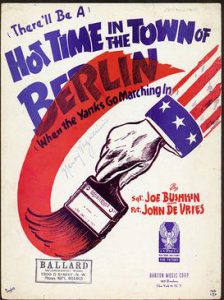 Dwight Eisenhower let the Soviets conquer Berlin, mainly to save American lives. British Prime Minister Winston Churchill and Field Marshal Bernard Montgomery disagreed with the Western Allies’ strategy of halting along the Elbe River and linking with Soviet troops in central Germany along the Erfurt-Leipzig-Dresden axis. Montgomery wanted to lead a single thrust into Berlin with Anglo-American forces under his command. However, after “Monty” pestered “Ike” for weeks, the Supreme Allied Commander finally boiled over and reminded him in no uncertain terms who was in charge and that a Berlin invasion wasn’t in the works. Bing Crosby had a hit in 1943 with “[There’ll be a] Hot Time in the Town of Berlin [When the Yanks Go Marching In],” but the Yanks never marched into Berlin until its post-war occupation. Ike was conscious of preserving American resources for the Pacific War and Soviet troops were much closer to Berlin anyway. He liked to move across a broad, steady front and attacking Berlin would’ve entailed Monty’s narrow thrust to get there by the time the Soviets arrived. Arriving late to the party could’ve been awkward and the American-Soviet alliance was delicate enough as it was. Conquering the capital was of little strategic importance because Berlin’s fate had already been decided at the Yalta Conference, where the Allies agreed to divide it up into zones. The potential pitfall of Eisenhower’s plan was the possibility that Stalin might’ve welshed on the Yalta agreement, but he didn’t.
Dwight Eisenhower let the Soviets conquer Berlin, mainly to save American lives. British Prime Minister Winston Churchill and Field Marshal Bernard Montgomery disagreed with the Western Allies’ strategy of halting along the Elbe River and linking with Soviet troops in central Germany along the Erfurt-Leipzig-Dresden axis. Montgomery wanted to lead a single thrust into Berlin with Anglo-American forces under his command. However, after “Monty” pestered “Ike” for weeks, the Supreme Allied Commander finally boiled over and reminded him in no uncertain terms who was in charge and that a Berlin invasion wasn’t in the works. Bing Crosby had a hit in 1943 with “[There’ll be a] Hot Time in the Town of Berlin [When the Yanks Go Marching In],” but the Yanks never marched into Berlin until its post-war occupation. Ike was conscious of preserving American resources for the Pacific War and Soviet troops were much closer to Berlin anyway. He liked to move across a broad, steady front and attacking Berlin would’ve entailed Monty’s narrow thrust to get there by the time the Soviets arrived. Arriving late to the party could’ve been awkward and the American-Soviet alliance was delicate enough as it was. Conquering the capital was of little strategic importance because Berlin’s fate had already been decided at the Yalta Conference, where the Allies agreed to divide it up into zones. The potential pitfall of Eisenhower’s plan was the possibility that Stalin might’ve welshed on the Yalta agreement, but he didn’t.
Toward the end of the Battle of Berlin in May 1945, Hitler committed suicide in a basement bunker with his mistress Eva Braun. The Third Reich collapsed only twelve years into its hoped-for thousand-year reign. Hitler had delusions of victory until very late, even naïvely hoping that FDR’s death in April would mean America’s withdrawal from the war. FDR’s 3+ terms ended up coinciding with Hitler’s rule, from 1933-45, as he died a month earlier of a massive cerebral hemorrhage at the “Little White House” in Warm Springs, Georgia with his mistress Lucy Mercer Rutherfurd at his side. By February, Hitler was cut off from the cocaine/opiate (Eukodal) mixture he’d been addicted to since at least 1944 and experiencing withdrawals.
Several thousand Nazi officers escaped along “Ratlines” from Germany to neutral Switzerland and, especially, Argentina, whose president Juan Perón was a sympathizer. Adolf Eichmann, chief organizer of the Holocaust, wasn’t captured until 1960 and Josef Mengele, the “Angel of Death” from Auschwitz, died in Argentina in 1979. There’s no good evidence that Hitler was among those that got away. Mussolini died around the same time as Hitler — murdered along with his mistress by Italians resentful of what fascism had done to their country. Their bodies hung in Milan’s square for days as people took their frustrations out on them.
In Austria’s Tyrolean Alps, five days after Hitler’s suicide, an unlikely alliance of American and French troops and German Wehrmacht deserters defeated SS troops for control of a POW prison at Itter Castle. The European war was over. American, Soviet, and British leaders met again later that summer, this time in the Berlin suburb of Potsdam. FDR died in April 1945, so Stalin met with U.S. President Harry Truman and Prime Ministers Winston Churchill and (after July 26th) Clement Atlee. Talks continued at the Potsdam Conference on the fate of postwar Europe but focus shifted to the Pacific and whether the Soviets would break their truce with Japan and enter the war. An unspoken elephant in the room was the new atomic weapon that the Americans and British hadn’t let their Soviet “ally” in on, but that Stalin knew about. When Truman mentioned “the powerful new weapon” to Stalin, he just nodded disinterestedly.
Pacific War, 1944-45
After the Battle of Berlin, attention turned to Asia, where the U.S. was nearing the island of Japan. Animated Map The incendiary bombing pioneered over Germany — with its flammable gel-fueled slow combustion — was even more effective on Japan’s flammable wooden homes. General Douglas MacArthur, true to his word, led American forces across the Solomon Islands and New Guinea and liberated the Philippines from Japanese rule in 1944.
Airstrips in the Marianas put American B-29 bombers within round-trip range of Japan. The ensuing raids, aided by Norton Bombsites for precise targeting, killed more Japanese through incendiary carpet-bombing than the more famous atomic bombs that followed. It was a mix of strategic bombing aimed at factories, refineries, and railroads, and the type aimed at civilians. Tokyo sustained more bombing damage in WWII than any city in history. One cluster of incendiaries there killed over 90k on March 9, 1945 — to date, the most deadly bombing attack in history. While the main targets were industrial and tactical (military), the “kindling” for the fires were wooden homes filled with people. In May, two more waves of 500 B-29s each dropped over 8500 tons of bombs, destroying 56 square miles. By early summer around a million Japanese civilians were dead. American General Curtis LeMay said, “I suppose if I had lost the war I would’ve been tried as a war criminal…But all war is immoral and if you let that bother you, you’re not a good soldier.”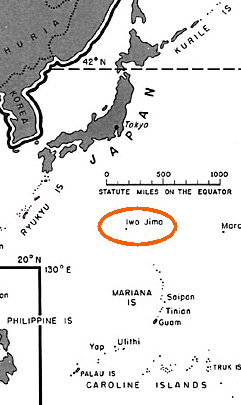
The closer Americans got to the main island of Japan, the fiercer the resistance. The Pentagon bickered over whether it was worthwhile to take more small islands between Japan and the airstrips they already held. American forces suffered 10k casualties on Peleliu for an island of questionable strategic value. Intelligence failed to realize that the Japanese there were dug into an extensive network of caves and there was no fresh water. The Palau Islands are in the western chain of the Caroline Islands in Micronesia, in the bottom left-hand corner of the map on the right. Between Japan and Saipan lay the small volcanic island of Iwo Jima. Japanese there were able to radio ahead when B-29s flew overhead toward the main island.
In early 1945, the U.S. resolved to take Iwo Jima rather than leapfrog it. They hoped to launch B-29 raids from there, but that never materialized. Like Peleliu, fighting on Iwo Jima was especially difficult because the Japanese weren’t just on the island; they were dug into its soft basaltic rock. The costly victory ended up symbolizing the Pacific War, especially with the country paying full attention since the European war was nearing its conclusion. Iwo Jima was the only post-Pearl Harbor battle of the Pacific War in which American casualties outnumbered the Japanese. The second photo atop Mt. Suribachi — after reporters on ships off the coast requested a larger flag — became the Pacific War’s iconic image, memorialized as a statue in Arlington Cemetery outside Washington, D.C.
Next up was Okinawa, the last main island before Japan, about halfway between Taiwan and the Japanese archipelago’s southern tip. Just a year after the Normandy Invasion in France, the Battle of Okinawa was the largest amphibious landing in naval history. The island is crisscrossed by rocky escarpments on which Japanese troops strung wire, sited mortar, and fought to the death. Multiple typhoons complicated the operation. Around 100k Ryukyuan civilians died, many from a mass suicide set off when the Japanese military warned them of how American G.I.’s would supposedly treat them, and others when Americans threw grenades into underground caves they were hiding in. A similar scenario transpired on Saipan earlier, when civilians jumped to their deaths off cliffs. Eight-thousand Japanese civilians, along with Navy Admiral Nagumo, took their own lives on Saipan. Many mothers killed their own babies rather than let them fall into American hands. While some American troops abused civilians, it wasn’t the norm and definitely wasn’t policy, making the misunderstandings on Saipan and Okinawa particularly tragic. At the same time, these mass suicides make one wonder what would’ve happened had the U.S. invaded Japan. Okinawa and Saipan are very small compared to the main island. American forces, including those offshore, suffered ~ 50k casualties in the Okinawa invasion, including 7.6k killed.
Offshore, in spring 1945, kamikaze (divine wind) pilots flew suicide missions into American ships, sinking around 50 and damaging another 300 – not a huge number in comparison with the overall war, but horrific nonetheless for sailors trying to fend them off. This wasn’t a Sunday afternoon at the range shooting clay pigeons. Gunners taking aim at kamikazes knew they had to hit their targets or die along with their shipmates. Usually, that meant drowning or burning to death. The USS Bunker Hill absorbed two hits on its flight deck 30 seconds apart on May 11th, causing over 600 casualties. Many died when the ship’s ventilation system sucked toxic fumes and burning gasoline below deck.
Kamikaze pilots with 1200 kg bombs in their plane’s nose were soldered into their cockpits and given enough fuel to get out to American ships, but not back. The American fleet amassing for an invasion was anchored beyond the range of round-trip flights, so they were taken off guard at first by the one-way missions. Since only bachelors could be kamikazes, some killed their families to qualify. Next to boxes marked eager or very eager, they signed in blood. Around 4k volunteered and 15% hit their targets. Suicide pilots also steered kaiten torpedoes into American ships under the surface. On land, Japanese soldiers rushed at Americans in swarms with bamboo spears and pistols, while others ran under American tanks with satchel bombs and blew themselves up along with everyone inside. Such sacrifices were rooted in the Japanese samurai tradition and bushidō code of chivalry, which called for loyalty and honor until death.
It was obvious that a potential invasion of Japan would cost many lives, on both sides. Hawks in the Japanese Parliament hoped that a protracted war on the main island would compel the U.S. to sue for peace on favorable terms, allowing the political regime to stay in power and for the Japanese to retain some overseas territory. Fanatics in the military insisted on keeping up the fight. Emperor Hirohito was powerless to convince the Hawks otherwise because they would’ve deposed him if he’d wanted to give up. The phrase Golden Gate in ’48 etched next to a sailor’s bunk on an American ship indicates what American servicemen thought they had in front of them. In 1945, they hoped to sail back into San Francisco Bay victorious in three years.
Atomic Bombs
The U.S. hoped to compel Japan to surrender with an atomic bomb. The bomb’s history traces to the European rather than Pacific war. Germans split a uranium atom in 1938, releasing 200 million volts of electricity. Physicist Lise Meitner coined the term fission to describe the process. A fissile material, such as Uranium-238, is one capable of sustaining a nuclear chain reaction. Leó Szilárd alerted fellow physicist Albert Einstein that the Germans had cut off uranium exports from a mine they controlled in newly conquered Czechoslovakia. Einstein understood the implications of nuclear chain reactions once Szilárd laid it out. Decades earlier, his famous E=mc² equation elegantly described how, while the proportion of matter and (rest) energy is constant, matter can convert to huge amounts of energy. While this equation didn’t lead directly to fission bombs, it at least helped physicists measure their effectiveness. An optional article below explains in more detail. The upshot is that splitting the nucleus of an atom is like opening an oven door.
But Einstein’s role as “father of the atomic bomb” is overrated. He wasn’t directly involved, but is most famously associated with co-signing a letter drafted by Leo Szilárd and addressed to Franklin Roosevelt concerning the urgency of keeping up with German atomic research. While this letter didn’t lead directly to the Manhattan Project, as often misunderstood, the Western allies began atomic research around this time. Germany was home to the world’s leading quantum physicist, Werner Heisenberg, who wasn’t enthusiastic about the Nazis but was too patriotic to defect to the West. The U.S. Army Corps of Engineers charged Lt. General Leslie Groves with its Manhattan Project. Groves, who also oversaw the Pentagon’s construction, set to work lining up the country’s best scientists from leading universities. The British had shared some of their knowledge of atomic power with the U.S. as part of the Tizard Mission in 1940. The U.S. then worked with British and Canadians but not America’s other ally, the Soviets. The Manhattan Project was the first U.S. government-sponsored “crash program” in science, followed by others aimed at eradicating polio, landing on the Moon, and curing cancer.
A key technology facilitator was Alfred Loomis, whose mansion/laboratory in Tuxedo Park, New York hosted prominent scientists like Einstein, Heisenberg, Niels Bohr, and Enrico Fermi. Loomis, the younger cousin of War Secretary Henry Stimson, was a scientist by night and investment analyst by day. Sensing the market crash, he’d converted all his stock to gold in early 1929, then reinvested in stocks after the crash, using the money to bankroll military research at his Loomis Lab and MIT (Massachusetts Institute of Technology). These labs boosted the Manhattan Project and were crucial in improving radar enough to win the Battle of the Atlantic.
The poker-faced Stalin was nonchalant when new U.S. President Harry Truman told him about the weapon at Potsdam because the Soviets had infiltrated the Manhattan Project. They knew something was up when they realized that all the key American and British physicists suddenly stopped publishing in journals, so they started spying. Truman himself hadn’t known about the bomb as vice-president because FDR never bothered to share it with him; advisers briefed him when FDR died. When Truman took over as president in April 1945, Stalin knew more about the Manhattan Project than he did.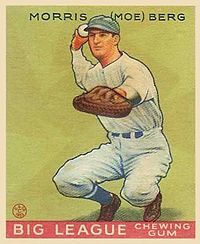
Partly because Hitler was suspicious of the many Jews involved in atomic science, Germany never fully embraced nukes the way they did aircraft or rockets. As early as 1920, thousands attended anti-Jewish science rallies in Germany, favoring what came to be known as Deutsche Physik. Werner Heisenberg had a tenuous relationship with the Nazis, who impatiently demanded that he make progress but didn’t sufficiently fund him. When the U.S. sent ex-baseball player and unlikely OSS spy Moe Berg to Zurich, Switzerland for a scientific conference in 1944, he refrained from assassinating Heisenberg because he determined that the Nazis weren’t on the verge of building a bomb. Though known among fellow ballplayers as exceptionally bright, Berg wasn’t a trained nuclear physicist. It’s surprising that the Allies put so much trust in his judgment given how much was riding on the nuclear race. Momentum could’ve turned in an instant had the Nazis gotten the bomb and, according to Berg’s personal account at least, they entrusted him with a momentous decision.
Germany tried to develop a weapon and got enough uranium from Belgium to accidentally blow up Heisenberg’s laboratory in a tiny blast. They had another facility in Norway, but Allied commandos sabotaged their heavy water (deuterium oxide) source at the Vemork hydroelectric/fertilizer plant in one of the war’s most exciting and seemingly important missions. Saboteurs parachuted in, ice-climbed their way up a cliff behind the well-guarded plant, broke in and destroyed the equipment. But the Germans rebuilt it. Then, after Germans loaded the requisite material onto a local ferry, Allied scuba divers planted explosives under the boat and blew it up in the middle of a lake, killing Swedish civilians on board in the process. They wouldn’t have died in vain had they really died to keep an atomic weapon out of Hitler’s hands, but analysis of containers in 2004 showed that it wasn’t enough to have been effective anyway. France had already purchased much of the Vemork plant’s heavy water and shipped it to England and then Canada once Germany invaded France. Germany never built an atomic bomb and there’s no evidence to suggest they got very close. They weren’t able to process uranium correctly to go critical (set off a nuclear chain reaction) and didn’t appear to have any centralized atomic program after 1942. Their ally Japan also had physicists that understood the technology, but they too lacked the materials and their focus shifted to microwave death rays. At most, they set off only tiny atomic explosions.
The Western Allies had better resources and key immigrants like Enrico Fermi, who fled Italy in 1939 to escape Mussolini. The Manhattan Project began at Columbia University (NYC) and the University of Chicago, where scientists led by Fermi split an atom in an abandoned squash court under the football stadium, Stagg Field. The Chicago Pile-1 reactor went critical in December 1942, meaning that it reached a small but self-sustaining chain reaction. Eventually, they deemed it wise to move experiments to less populated surroundings in New Mexico’s Los Alamos Laboratory. Los Alamos wasn’t the only facility, though. The project employed 600k workers from Oak Ridge, Tennessee to Hanford, Washington, to dozens of points in between.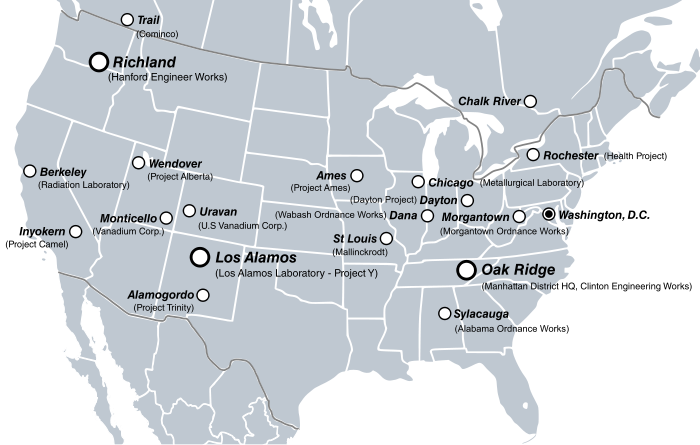
In the previous chapter, we saw female “computers” working in Los Alamos’ calculation wards, crunching random equations with Stanislaw’s Monte Carlo Method to discover the optimal way to set off a nuclear reaction. Many employees wouldn’t have recognized the term Manhattan and didn’t really know exactly what they were working on, other than it was a “gadget” that could end the war. One woman in Tennessee didn’t understand that she’d helped build an atomic bomb until she saw a photo of herself in a museum exhibit fifty years later. Manhattan employees were asked to do their patriotic duty and not ask questions. 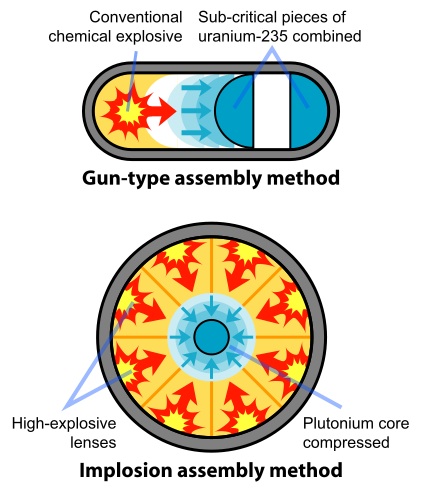
The most difficult task was converting the more common Uranium-238 to the rare U-235 variety necessary to set off a bigger reaction. Success requires so much U-235 that Danish physicist Niels Bohr said the U.S. couldn’t do it without turning the entire country into a factory. When he saw the huge facility at Oak Ridge, he said, “See, I told you so.” With the necessary amount, a nuclear explosion can grow exponentially, making it millions of times stronger than any other known chemical reaction.
Developing Plutonium-239 necessary for another type of weapon was also complicated. Plutonium isn’t found in nature. It can be manufactured in a reactor as a uranium byproduct. It’s dangerous work because the plutonium has to be scavenged from radioactive fuel rods. And plutonium is harder to detonate. The first gun-type plutonium gadget failed, melting the bomb instead of detonating.
Manhattan Project chief scientist J. Robert Oppenheimer was distraught and considered resigning but, instead, he led efforts into triggering plutonium through implosion. Implosion squeezes the core in equally from all sides enough for it to go critical, in this case from about the size of a softball to a baseball. Plutonium bombs, if they can be made to work, are stronger than uranium and the plutonium can be produced on a larger scale. Their split atoms release more neutrons and, since they are lighter, can potentially pack more punch on missiles (which didn’t exist in 1945).
The good news for the Manhattan Project was that the plutonium implosion method worked; the bad news was that one British physicist who helped bring that about, Klaus Fuchs, was a Soviet spy. Most nuclear physicists leaned left politically, which worked out fine initially insofar as everyone was united in fighting right-winger Hitler. But officials got sloppy in granting Fuchs clearance. The long-term arms race was with the USSR and some physicists were communists.
The weapons they envisioned were unlike anything mankind had thus far created in its long history of killing one another. Victims near the blast zone could be reduced to a silhouette against a brick wall and the explosions set off spontaneous small tornadoes. People further from ground zero would suffer burns and often cancer later since radioactive gamma rays scramble chromosomes in white blood cells. Scientists developed two types of bombs: a gun type-detonated uranium and implosion-detonated plutonium. Hanford, Washington bred plutonium while Oak Ridge, Tennessee enriched uranium. Physicists on the much smaller staff at Los Alamos concentrated mainly on explosives and how to detonate the bombs because they already understood the theoretical physics.
In July 1945, they exploded a plutonium implosion “gadget” at the Trinity Site, in the New Mexico desert, and secretly hauled two bombs, another plutonium and a uranium version, out to the Pacific to use on Japan. The Trinity Site bomb had a 3.6″ plutonium core and set off an explosion that knocked soldiers over six miles away. Physicists placed bets on how strong the explosion would be, with Oppenheimer putting his money on a “fizzle.” However, they weren’t as scared of a dud failure as they were of miscalculating how successful they’d be and accidentally blowing up humanity or even creating a small sun.
As it turns out, the explosion was 10x hotter than the Sun’s surface but, fortunately, didn’t create one. Atomic bombs fail to set off perpetual chain reactions because they tear themselves apart so quickly. The explosion — miniature by today’s hydrogen bomb standards — was equivalent to 18k tons of TNT, about 3x stronger than consensus estimates. The kiloton pool winner only guessed right because he arrived late and 18 was the last number left.
There’s a common misconception that the actual bombs, once they figured out how to make them, were more expensive and took longer to build than they really did. After Trinity, they realized that they could make more plutonium bombs in fairly short order, and they used a second on Nagasaki, Japan a month later. The gun-type uranium bomb dropped on Hiroshima was never tested – that was the test. Really, it was outdated by then and they should’ve turned around the boat, brought it home, and used its extensive uranium to fashion more efficient plutonium bombs. However, that would’ve forced the budget-conscious Groves to admit they’d squandered $1.2 billion at Oak Ridge (63% of their budget). Using letters between Groves and Oppenheimer, historian Bruce Hunt has shown that bureaucratic concerns dictated which bombs were used and why.
On the right is Robert Oppenheimer at Trinity Site with Leslie Groves after the blast. With superior funding and Nazis favoring “Aryan physics” over “Jewish physics,” the American Jewish-German immigrant’s team pulled ahead of Heisenberg’s (another Jewish-German) and won the race to build nuclear weapons. In a fortunate case of cosmic justice, anti-Semitism helped prevent Germany from developing an atomic bomb. But Oppenheimer later lost his security clearance during the Red Scare when he was associated with communism and opposed development of bigger hydrogen bombs.
Some people have cited racism as a motive for the U.S. dropping atomic bombs on Japan but, until 1944, the program’s original purpose was to build a weapon intended for Germany, or at least as a deterrent against a German bomb. The Allies showed no compunction about bombing German civilians with incendiary bombs. However, the war with Germany ended before they developed an atomic bomb. Meanwhile, peace talks with Japan suffered from poor communication and stubborn resistance on the part of Emperor Hirohito, who seemed unconcerned with the civilian casualties suffered in the B-29 raids. Japan, not Germany, ended up in the crosshairs after the Manhattan Project had poured years of effort and money into building atomic bombs.
Hiroshima & Nagasaki
When American diplomats broached the idea of negotiating a truce without invading Japan, some Japanese leaders misunderstood their intentions and thought the U.S. was giving up and capitulating. At the Potsdam Conference in July 1945, the U.S. and Britain demanded Japan’s unconditional surrender, with terms including forfeiture of all overseas territories, war crimes for unusual cruelty toward POWs, and amnesty for common Japanese military personnel. “We will not deviate [from the terms]. There are no alternatives. We will brook no delay.” Japan would retain its sovereignty, but the current leaders had to step down. “There must be eliminated for all time the authority and the influence of those who have deceived and misled the people of Japan into embarking on world conquest, for we insist that a new order of peace, security and justice will be impossible until irresponsible militarism is driven from the world…the alternative for Japan is prompt and utter destruction.”
Historians debate whether Japan was already willing to surrender, at least conditionally, prior to the atomic attacks. Truman suspected they might surrender when the Soviets entered the war. On July 17th, he wrote this entry in his diary: “He’ll [Stalin and the USSR] be in the Jap war on August 15th. Fini Japs when that comes about.” Some analysts argue that the Japanese were willing to surrender as long as Emperor Hirohito was allowed to stay on the throne. Stalin told UK Prime Minister Clement Atlee as much at the Potsdam conference. As he was negotiating with the Soviets on July 17th, Japan’s Foreign Minister Shigenori Tōgō sent this message to fellow diplomat Naotake Satō: “If today, when we are still maintaining our strength, the Anglo-Americans were to have regard for Japan’s honor and existence, they could save humanity by bringing the war to an end. If, however, they insist unrelentingly on unconditional surrender, the Japanese are unanimous in their resolve to wage a thoroughgoing war.” On July 18th, Truman wrote: “Stalin had told [British] P.M. of telegram from Jap emperor asking for peace. Stalin also read his answer to me. It was satisfactory. Believe Japs will fold up before Russia comes in [the war]. I’m sure they will when Manhattan [the atomic bomb] appears over their homeland.” There were several other peace feelers sent from Japan to the USSR, including one on July 25th, 1945 suggesting that Japan would be open to a settlement in keeping with the Atlantic Charter (State Department: Office of the Historian). That’s vague because the 1941 charter struck by FDR and Churchill dedicated the allies, postwar, to democracy and decolonization, but didn’t directly concern emperors, bombs, territories, or surrenders. It’s confusing because not only was Japan sending its messages to the U.S. and Britain through the USSR, it was also negotiating with the Soviets, trying to keep them out of the war. The Japanese may have also contacted General MacArthur about a surrender months earlier, after their 1944 defeat in the Philippine Sea and Marianas when FDR was still president, but the evidence for that is a mixture of hearsay and murky sources (see Wellerstein’s third optional article below).
The emperor’s status was no small matter. Even though the emperor didn’t run the country directly, he was more influential than, say, the ceremonial Windsor monarchy in Britain. In the kokutai tradition, many Japanese viewed their divine emperor more the way traditional Catholics view the Pope, except that rather than being an embodiment of God, the emperor embodied the land, history, and its people. However, there’s a flaw in the theory that Japan was willing to surrender as long as they retained an emperor. Despite consistent setbacks and steady erosion of territory since mid-1942, some elements in Japan wanted to fight on. The Tōgō message to Satō suggests they wanted to retain their territories with their current political and military leadership in place “when we are still maintaining our strength.” Or, at least it could be interpreted that way; maybe by “full strength” he just meant keeping the emperor in place. Either way, it doesn’t say: we’re willing to give up, relinquish territory and step down as leaders as long as the emperor stays. According to messages the American Magic program intercepted and deciphered — released by the NSA in 2005 — the Japanese were arguing amongst themselves over what to do throughout July. Some favored a peace settlement, perhaps with the USSR acting as a mediator, while others favored continuing. They had decreed in April 1945 that they’d fight to the last person, though that was three months earlier. As mentioned, a few hardcore hawks even saw any peace entreaties from the enemy as a sign of their weakness, meaning that the U.S. was about to give up. Japan held more territory as of August 1945 than is commonly realized and they hoped to play the Soviets and Americans against each other and use a three-way deal to swap foreign territory in exchange for maintaining autonomy on the island of Japan. The map below shows territory Japan held as of August 1945 in green, with much of the northern white area threatened by the Soviets (note: if you become a cartographer, please use blue for oceans).
Aside from hearsay and intercepted messages, what did the U.S. really know leading up to Hiroshima and Nagasaki? Japanese Prime Minister Kantarō Suzuki rejected the July 26th Potsdam Declaration on August 2nd, four days before the Hiroshima attack. He didn’t reject it, so much as he ignored it in the tradition of mokusatsu, “to treat with silent contempt.” Evidently, the military factions in Parliament and on the War Council wanted to fight on rather than surrender unconditionally or they needed more time to consider. The War Council was split on whether to try for a negotiated settlement that would’ve allowed Japan to retain some of its conquered territory and for its leaders, not just the emperor, to stay in power. The U.S. Strategic Bombing Survey backed the testimony of some surviving Japanese leaders that Japan would’ve surrendered by November 1945 without the atomic attacks, Soviet invasion or “even if no invasion had been planned.” But that’s dubious testimony after the fact and the allies’ report is conjectural. What the survey should’ve said is that Japan should have wanted to surrender that fall even without the invasion or bombs had they been unified and thinking rationally about their prospects while American and Asian lives would’ve been at risk in the meantime. All we know for sure is that, as of August, no clear, direct, surrender offer from Japan to the U.S. was forthcoming. The myth that Japan wanted to surrender lives on partly because, as students of history, we’re in the emotional market for stark moral choices of good vs. evil and, had the U.S. refused a straightforward offer, they would’ve been more clearly in the wrong.
Let’s unpack this further because it’s important. American intelligence had intercepted earlier, more capitulatory messages indicating that Japan was willing to surrender as long as the U.S. left the emperor on the throne, but they came between January and May 1945, via neutral intermediaries Sweden and Portugal. These messages didn’t clearly indicate that government officials other than the emperor would step down, including the political and military leaders who’d brutalized Asia for years. The rest of the world had every right to demand their resignation. They had the right to demand the emperor’s capitulation, for that matter. If these messages had clearly stated Japan’s position — and better yet, publicly proclaimed it — critics would be more justified in asking why the U.S. didn’t just accept the unconditional terms. That would’ve brought an end to the fighting on Iwo Jima (February and March) and Okinawa (May-June), along with the civilian suicides, kamikaze attacks, and fire-bombings on the mainland, to say nothing of preventing the atomic attacks. As we’ll see below, the U.S. left the emperor on the throne anyway after the war. The U.S. also attained some third-party communication through the Soviets, but Stalin downplayed the peace entreaties, claiming that the peace party in Japan was small and uninfluential. Stalin may have been right, but he had his own motives, hoping to extend the war to acquire more eastern territory.
As it turns out, the Japanese didn’t surrender after the first atomic attack, and even then many historians argue that was only one factor in their surrender. If it seems strange that Japanese leaders weren’t more shocked by the atomic blasts, keep in mind that more civilians died in incendiary carpet-bombings earlier that year. The U.S. had already played that hand and Hirohito had already shown that he didn’t care. His bigger concern was that royal heirlooms not fall into enemy hands.
Three main factors prevented an earlier end to the war. First, the Japanese never reached a consensus on who would be willing to step down or even whether to continue fighting and retain foreign territory in a settlement. Second, there weren’t effective means of clear, well-translated two-way communication between the U.S. and Japan, leading to garbled messages, third-party hearsay, and misunderstandings. By going through Stalin, the Japanese were using an intermediary who wanted to delay peace until he could get a piece of the pie. It’s surprising Stalin even mentioned the peace feeler at Potsdam. Third, the wheels were already in motion on the Manhattan Project and the U.S. never seriously pursued an earlier negotiated settlement. The bomb had the unstoppable force of bureaucracy behind it.
Truman, for his part, didn’t seem interested in pursuing the vague peace feelers that fell into the hands of American intelligence. Even when Japan finally offered to surrender the day after the Nagasaki attack (August 10th), Truman was miffed about their insistence on leaving the emperor on the throne: “Ate lunch at my desk and discussed the Jap offer to surrender…Our terms are unconditional. They wanted to keep the emperor. We told ’em we’d tell ’em how to keep him, but we’d make the terms.” Others charge that Truman’s advisors wanted him to relay the message to Japan about leaving the emperor in place and he never did. It’s obvious, either way, that communications were bad between the U.S. and Japan. Japan should’ve clarified their position to Truman unequivocally since his job as Commander-in-chief was to shorten the war and win it with as few American casualties as possible.
Late in his life, Truman told historian Thomas Fleming that he wanted to negotiate a peace and didn’t care about unconditional surrender and that FDR’s residual staff pressured him into dropping the bombs. That doesn’t square with what Truman wrote in his diary at the time, but there might be some truth to the idea that Truman wasn’t running the show. This is one case where people might overestimate the president’s role in decision-making. The wheels were already in motion to use atomic weapons before Truman took office after FDR’s death in April 1945. The Manhattan Project’s head, Leslie Groves, described Truman as a “little boy on a toboggan…along for the ride,” though he later denied it to Truman. In fact, there’s no actual document from early August showing Truman authorizing the attacks. On the back of a letter from Secretary of War Henry Stimson — often cited by historians as the moment when the president made his fateful decision — he wrote, “Suggestions approved…Release when ready but not before August 2nd [signed] HST.” However, Truman was referring to the nature of the press release after the bombings, not the bombings themselves.
The document ordering the attack is between two generals, Thomas Handy and Carl Spaatz. Groves wanted to use both the uranium and plutonium bombs regardless of the broader diplomatic context, fearing that all the research would’ve been a waste of time and money without implementing them. If one bomb could’ve ended the war, using two for this reason was a callous example of the sunk cost fallacy. But this was Groves’ personal legacy and he knew that Truman, of all people, hated wasteful military spending since he’d made his name in the Senate as Chair of the cost-cutting Truman Committee. Secretary of War Stimson and Secretary of State James Byrnes pushed for dropping the bombs and Truman went along with it. Truman might not have authorized the second attack on Nagasaki either. But, after the war, Truman referred to the decision as if he’d made it, telling Oppenheimer that the blood was on his hands, not Oppenheimer’s. In this case, the Commander-in-chief’s role was maybe to just not interfere with what was playing out around him. Truman wrote in his diary on July 25th that he instructed Stimson to only use the atomic weapon on military and industrial targets and to avoid women and children, showing that he was in the loop as of late July but not fully in control of how they used the bombs. The optional blog by Wallerstein below analyzes primary sources to suggest that Truman was under the impression that Hiroshima was just a military target rather than a military base within a city.
According to William D. Leahy, who chaired what soon came to be known as the Joint Chiefs of Staff, the atomic attacks were unnecessary and all the U.S. had to do to end the war was simply assure Japan that the emperor would be left in place. In Leahy’s opinion, the U.S. set an ethical standard common to the “barbarians of the Dark Age” by murdering women and children. General MacArthur wanted to continue conventional bombing combined with a blockade, but that might not have saved Japanese lives in comparison to the two atomic bombs. Dwight Eisenhower concurred with Leahy that “the Japanese were ready to surrender, and it wasn’t necessary to hit them with that awful thing.” Fleet Admiral William “Bull” Halsey felt the same way, as did Brigadier General Carter Clarke, who thought surrender was imminent and argued that the U.S. just used Japan for a bombing experiment. Former president Herbert Hoover said the indiscriminate killing of women and children “revolts my soul.”
Historians should always look for broader context, and here it’s worth mentioning that once everyone knew the Air Corps (or Army Air Force) was going to branch out of the Army and form the Air Force, and that the Air Force was going to bogart nuclear funds, Army and Navy brass opposed nuclear weapons on “moral grounds.” When they later realized that other branches would get nukes too, they warmed quickly to their effectiveness and practicality. The debate surrounding Truman’s decision to greenlight the atomic attacks is also complicated by the inexactitude of estimates as to how many lives a traditional invasion or continued conventional bombing would’ve cost (if an invasion was necessary). According to unverified sources, Truman was told that thousands of American troops would be killed in the proposed land invasion (Operation Downfall) and he said months later that he thought “a quarter-million of the flower of our young manhood [was] worth a couple of Japanese cities.” If Saipan and Okinawa were indications, then Japanese civilian casualties would’ve been enormous, and military casualties on both sides at Iwo Jima were steep. Those islands were small, whereas two million soldiers and many more civilians defended the main island of Japan. Other critics suggest that the U.S. could’ve dropped a demonstration weapon and they had discussed doing just that as far back as 1944. That might’ve been practical with a plutonium device but not uranium, of which they had just one large bomb and several smaller ones. It also would’ve backfired diplomatically if it hadn’t worked. Historian/journalist Paul Ham argued here that Truman had already abandoned invasion plans in July 1945, hoping to just rely on the blockade, but doesn’t provide evidence that Operation Downfall was already cancelled even before they decided to drop the atomic bombs.
For an even fuller context of August 1945, consider not just the war against Japan, but rather the beginning of the Cold War between the U.S. and Soviet Union. When the U.S. met with Soviets at Potsdam, the Soviets signaled their willingness to open up a front against Japan. Earlier, at the Yalta Conference in February 1945, FDR wanted help against Japan. But by Potsdam in late July 1945, the U.S. feared the Soviets were getting in on the spoils at the end after the U.S. had done the heavy lifting. The U.S. had, by now, tested one of “the gadgets” in New Mexico — all the more reason they didn’t need Soviet help. Moreover, bombing Japan could demonstrate the new weapon for the Soviets’ benefit, or even preclude them from taking more territory in East Asia than they already had, perhaps even Japan itself. Secretary of State James Byrnes was especially intent on demonstrating for the Soviets. The Soviets had a larger army, but the U.S. now had a new “master card” to offset that and they wanted the Soviets to know they were willing to use it. In this case, demonstration didn’t just mean a successful test in New Mexico, but rather the willingness to use it on civilians. Secretary of War Stimson chose industrial targets over the religiously and culturally important city of Kyoto because he feared that bombing Kyoto would make the Japanese less likely to favor the U.S. over the USSR after the war. Tokyo wasn’t a good option because it was already destroyed.
Historians have increasingly emphasized the Soviet factor, especially after examining Truman’s own letters. Prior to the Trinity Test, Truman wrote: “If it explodes, as I think it will, I’ll certainly have the hammer on those boys.” But the boys were the Russians sitting across the table from him at Potsdam, not the Japanese. Tsuyoshi Hasegawa’s Racing the Enemy (2005) documents this triangular diplomacy and confirms that Stalin viewed Hiroshima and Nagasaki as affronts to the USSR. While Stalin was coy at Potsdam when Truman first mentioned they had a bomb, he was less sanguine to Soviet scientists after Hiroshima and Nagasaki, beseeching them, “The balance [between the two future superpowers] is destroyed, that cannot be.” The Soviets planned to enter the war against Japan in mid-August, three months after the war in Europe was over. The timing of the U.S. atomic attacks coincided with Soviet entry into the war.
On August 6th, three days before the Soviets were to enter the war, the U.S. dropped the uranium bomb Little Boy out of the B-29 Superfortress Enola Gay on Hiroshima, Japan. You’ll remember that no uranium bomb had been tested up to that point. The bomb decimated the city of 140k people, directly killing 60-80k and damaging a U.S. POW camp outside town. Koreans (10%), Peruvians, and Bolivians working in the city’s military factories were also among the dead and hibakusha (survivors). Since the city hadn’t been carpet-bombed, its people were unfamiliar with air raid sirens and even those that heard the warning didn’t understand why one solitary bomber would trigger such a warning; bombers usually flew in squadrons. With bridges destroyed, survivors escaped across makeshift pontoons of corpses blown into the city’s many rivers.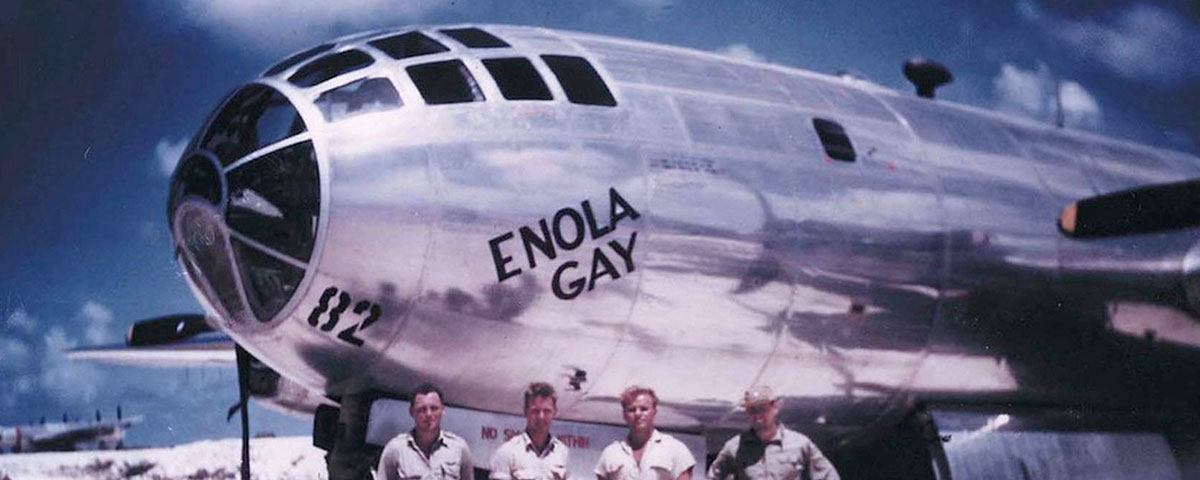
Total casualties including radiation poisoning by year’s end were over 150k, making it ultimately more deadly than the Tokyo fire-bombings. Physicist Hermann Muller discovered the impact of radiation on cells at the University of Texas in the 1920s, winning the 1946 Nobel Prize. Yet, after Hiroshima, he told reporters that victims were often luckier to be killed directly by the blast than injured because super-charged gamma-ray free radicals released by nuclear weapons tear up DNA, cleaving the double helix’s phosphate-sugar backbone and inhibiting cells’ ability to make proteins. In the short term, survivors experienced burns right away and vomiting, peeling skin, headaches, and internal bleeding within a week. Leslie Groves contributed to the propaganda testifying to Congress that “[A]s I understand it from the doctors, it is a very pleasant way to die.”
Still, the Japanese refused to surrender after Hiroshima, though we now know that they would’ve surrendered soon just after Hiroshima because they preferred surrendering to the U.S. rather than the USSR, making the second Nagasaki attack tragically superfluous in hindsight. Truman released a statement to the public, stating that it was to avoid such a catastrophe that he’d offered terms to Japan at Potsdam on July 26th. “If they do not now accept our terms, they may expect a rain of ruin from the air, the like of which has never been seen on this Earth.” Japan responded only with more mokusatsu (silence).
The U.S. then went after a strategic industrial target, Kokura, with a plutonium-core bomb, Fat Man, similar to the one tested at Trinity Site, New Mexico the previous month. The mission was fraught with mechanical problems and disorganization, including failure to rendezvous with other planes and a mixup on altitude. Kokura was mostly covered with clouds so the B-29 carrying Fat Man, Bockscar, turned around to return to the Marianas before running out of fuel. The clouds cleared over Nagasaki, where they’d already bombed the Mitsubishi Steel & Arms Works the week before with conventional weapons. It was the second time (after Midway) a chance clearing had helped dictate the war’s course, if indeed the pilots were telling the truth. They’d been instructed to rely on visual confirmation and not use radar, but likely didn’t want to drop the bomb in the Pacific and they didn’t want to risk landing with it. Bockscar dropped and detonated their plutonium bomb, killing another 70-80k. Many of Nagasaki’s factories and buildings melted like wax from a candle, despite them missing their intended industrial target and detonating the bomb over a northern residential district. The city’s hills prevented the scale of destruction seen at Hiroshima. The Bockscar was so low on fuel that it couldn’t make it back to Tinian (Marianas) and landed at Okinawa with no clearance. It ran out of gas as it landed and had to be towed off the runway.
Tsutomu Yamaguchi was one of around 160 people to survive both blasts and died in 2010 at age 93. He worked at Mitsubishi Heavy Industries in Nagasaki but visited the company’s office in Hiroshima on August 6th. Another nijyuu hibakusha (double-exposure survivor) had clawed his wife’s bones out of her charred body in Hiroshima to return to her parents in Nagasaki. In Yamaguchi’s case, he was sick the first year with nausea and peeling skin and passed on compromised immune systems to his post-1945 children, but his own cells had an extraordinary capacity to repair DNA. Ted Fujita, a young engineer who studied the Nagasaki blast, later moved to the U.S. as a meteorologist and pioneered tornado studies — he’s the F in the F-scale, as in an F-5 twister — and discovered micro-burst downdrafts, the knowledge of which has saved countless lives among air passengers (he noticed the similarities between the debris in some plane wrecks with the area under the Nagasaki ground-zero detonation).
The Nagasaki attack was on August 9th, just as the Soviets entered the war they declared against Japan on August 8th. In the brief Soviet-Japanese War, the Soviets had already crossed the Khingan Mountains and invaded Manchuria (NE China), Sakhalin, North Korea, and the Kuril Islands, and they continued to step on the gas even after Japanese surrendered. These invasions were instrumental in helping communists win the ensuing civil war in China and in occupying North Korea. Japan, too, feared a Soviet invasion. They’d fought Russia in 1905 and knew the godless communists would overthrow their emperor if they occupied Japan. On August 14th, Japan accepted America’s terms of unconditional surrender from the Potsdam Declaration (except for the emperor stepping down) and aerial combat continued between American Avengers and Japanese planes until then. The swift Soviet victories, along with the atomic bombs and continued American naval embargo, contributed to Hirohito’s capitulation.
The aerial photos of mushroom clouds and devastation are from the American perspective. The Japanese had a different perspective. Their propaganda office sent photographer Yōsuke Yamahata to Nagasaki in the aftermath to take pictures that would motivate people for the final battle that would ensue with the American invasion. He took these shots of Nagasaki on August 10th and never released them to the government.
Japanese representatives met General MacArthur in Manila to discuss details. When American troops drove into Japan, sentries kept their backs to the road in what the victors initially thought was a show of disrespect. Really they turned their backs as a show of respect for their conquerors. The U.S. didn’t allow either Russians or even the British and Australians to enter Japan. The Japanese signed surrender terms in Tokyo Harbor aboard the USS Missouri, a ship damaged at Pearl Harbor four years earlier. The U.S. took control of Japan, re-writing its constitution, barring it from maintaining a large military, and rebuilding the country on its own terms as a capitalist democracy. As indicated, despite all the controversy over the emperor’s status, the U.S. left him on the throne anyway. Japan demanded as much as a condition of surrender even after Nagasaki. The U.S. didn’t have enough atomic weapons in its arsenal to make them budge on this matter, so they basically gave up. MacArthur hoped that retaining Emperor Hirohito during Occupation and Reconstruction would smooth the peaceful transition and he stayed on as Japan’s ceremonial leader until 1989. Japan voted to expand its military beyond a merely defensive role in 2015.
The American missions conveying the bombs to Tinian in the Mariana Islands were so secret that most of the Navy didn’t know about them. Consequently, when a Japanese sub torpedoed the USS Indianapolis cruiser on its return voyage (the one that delivered the uranium and trigger mechanism for Little Boy), no one came to rescue the sailors. It was the single greatest loss of life in American naval history (approx. 900), with many crew that didn’t succumb to drowning, exposure, or dehydration being eaten by sharks. Over 300 survived after being spotted by a plane. In Steven Spielberg’s Jaws (1975) the gruff shark hunter Quint, played by Robert Shaw, recollects his experience after the Indianapolis sank (video).
It underscores the magnitude of WWII to argue that the U.S. had to drop atomic bombs on Japan just to end the violence, yet that very case can be made. The full story doesn’t lend itself well to moral clarity. FDR’s replacement, Harry Truman, is commonly portrayed as feeling no compunction about the attacks, but it weighed on him over the years. In 1948, he said the Japanese bombings showed that nuclear weapons are “used to wipe out women and children and unarmed people, not for military use” — strong words from the man who either ordered the attacks or failed to stop them. In his 1953 Farewell Address, he added that starting a nuclear war would be unthinkable for rational men. In any event, the genie was out of the bottle as far as nuclear power. Even if WWII had zero impact otherwise, that alone would’ve changed the world forever. While the first atomic bombs were small by today’s standards, within fifteen years the Americans and Soviets developed hydrogen bombs large enough to end life on Earth as we know it if too many were deployed at once.
Conclusion
Defending the free world by winning two wars at once is rightfully considered one of America’s greatest accomplishments. Through team efforts and heroics at home and abroad, the U.S. and its allies — far from perfect in their own right — saved the world from the sadistic barbarians who then ran the Axis Powers and held much of the world hostage. Victory catapulted the U.S. into a position of economic and military supremacy it’s maintained ever since. They controlled most of the world’s gold, doubled their amount of overseas bases, doubled their GNP and, for the most part, controlled the world’s economy. Americans had more steel than they could use, more clothes than they could wear, and more food than they could eat.
Consequently, it’s easy for Americans to overlook that WWII was the worst thing that’s ever happened. By 1945, the world had gone through years of unbridled slaughter and mayhem, with the veneer of civilization peeled back to expose the most vicious sides of human nature. No one knows for sure, but it’s estimated that around 62-78 million people died in WWII. Around two-thirds were civilians. It was the worst war of all time in terms of total numbers, and probably either the second or third worst in proportion to the population, behind China’s An Lushan Rebellion (755-763 CE) and, perhaps, the Mongol Invasions of Russia and Europe that were spread out over a longer time period.
In WWII, the U.S. got off easy in comparison to other countries, with only 0.32% of its population losing their lives compared to 12-15% in Poland, the USSR, and Baltic countries (Latvia, Lithuania, Estonia). China suffered somewhere from 7-16 million civilian casualties, and Russia lost 20-25 million civilians. Luckily, U.S. civilians went unharmed other than those injured or killed in factories. Nonetheless, America had more combat casualties than in any conflict besides the Civil War with around one million of 16 million serving getting injured or killed. As we saw above, around 75% of American casualties were in Europe in 1944-45.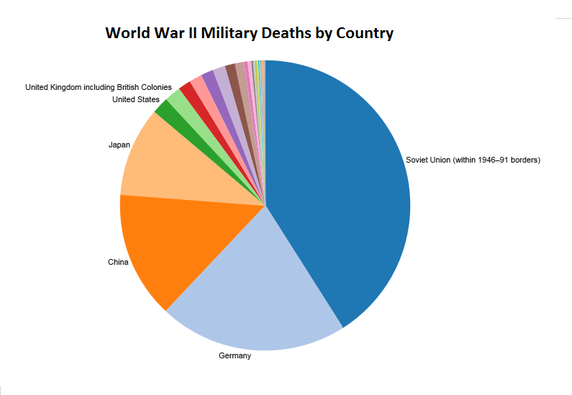
By the end, even the good guys were killing civilians on an unprecedented scale without blinking an eye. Still, despite two horrific world wars and several smaller conflicts, Japan, China, the U.S. and European countries killed each other at a lower rate than traditional, tribal societies in Africa, South America, and the South Pacific did during the 20th century. If these societies represent what life was like everywhere for ancient man, as anthropologists suggest, then we’re gradually getting more peaceful. Perhaps the modern nation-state, while most noticeably the cause of conflicts, also provides a mechanism to stop the otherwise never-ending cycle of violence and retribution.
But outside America, these nation-states were battered by 1945. Economically, much of the industrialized world lay in ruins after WWII. Diplomatically, the conflict segued into the Cold War between its two main victors, the U.S. and Soviet Union, hastened the establishment of Israel and ushered in an age of decolonization across the globe — all stories we’ll cover in coming chapters.
Today we live in WWII’s shadow, both in terms of the balance of world power and technology. The war accelerated advances in radar, penicillin, jet aircraft, rocketry, and computers. The evolution of penicillin and antibiotics is a story unto itself that changed world history for all of us. Weight lifting took off as orthopedists discovered resistance exercises could help rehabilitate injured veterans. Anglo-American T-Forces and Soviets swooped in to seize technology and recruit scientists from Germany’s chemical, biological, and atomic weapons research and rocket programs in Operation Paperclip. Their rocket program’s leader Wernher von Braun went on to lead NASA’s Marshall Space Flight Center and design the Saturn V rocket that propelled the Apollo craft to the Moon. America’s Joint Intelligence Objectives Agency (JIOA) renamed Operation Overcast Operation Paperclip because of false employment records and political biographies they clipped to scientists’ files to get around President Truman’s anti-Nazi policy. British and Americans got thousands of names of key scientists on documents discovered in a Bonn restroom. While the U.S. was lucky to discover V-2 blueprints at the Nazi’s Mittelbau-Dora rocket plant/slave camp, they carelessly left behind backup plans that Soviets discovered, aiding their version of Paperclip: Operation Osoaviakhim. The Space Race commenced as World War II ended.
Germany’s desperation toward the war’s end pushed its technology to the cutting edge of jets, guided missiles, and craft like the Horten long-range bomber that could evade radar. The Horten was one precursor, along with Jack Northrop’s own “Flying Wing,” to Northrop Grumman’s B-2 Spirit Stealth Bomber of the late 20th century.
One English code-breaker, Alan Turing, pioneered computer technology (the “electronic brain”) and helped lay the theoretical groundwork for artificial intelligence before being arrested for homosexuality and chemically castrated with estrogen. He committed suicide at age 41. Anticipating smartphones, Turing predicted, “One day ladies will take their computers for walks in the park and tell each other ‘My little computer said such a funny thing this morning.’”
Domestically, WWII revived the civil rights movement as America re-examined its own values after fighting racist regimes in Japan and Germany. It also led to employer-covered health insurance (e.g., Blue Cross Blue Shield) as firms competed for talent amidst a government-mandated wage freeze. That meant employers gradually assumed responsibility for such benefits instead of the government and is an important factor in why the U.S. was the only developed country to never provide its people public health insurance (the other reason is the political pull of private health insurance companies). Work breaks became routine to accommodate female factory workers.
At least the horrors of the Holocaust triggered an embarrassed retreat to the margins for American anti-Semitism, commencing what Atlantic recently described as a golden age for Jewish Americans, ~ 2.5% of the population, increasingly threatened from the left and right in the 2020s. After World War II, religious and ethnic Jews thrived in science (Albert Einstein, Jonas Salk, Robert Oppenheimer), literature (Saul Bellow, Philip Roth, Norman Mailer, Bernard Malamud), and entertainment (Steven Spielberg, Stanley Kubrick, Bob Dylan, Simon & Garfunkel, Lenny Bruce, Mel Brooks, Rod Serling, Barbara Streisand, Sammy Davis, Jr., Marylin Monroe, Woody Allen, Dustin Hoffman, Harrison Ford, Sylvester Stallone, Henry Winkler (the “Fonz”), Gilda Radner, Lenny Kravitz, David Lee Roth, Ben Stiller, Jerry Seinfeld, Adam Sandler, Sarah Jessica Parker, Paul Rudd, David Schwimmer, Larry David, and the Coen brothers, just to name a few of many). And Jewish Americans like Abraham Joshua Heschel, Michael Schwerner, Andrew Goodman were important enough allies with the African-American civil rights movement that the KKK blamed them for putting crazy ideas in Blacks’ heads. In the evolving prism of identity politics, where race is partially constructed, Jews became “white” Americans — a reversal of their failed European assimilation in the late 19th and early 20th centuries.
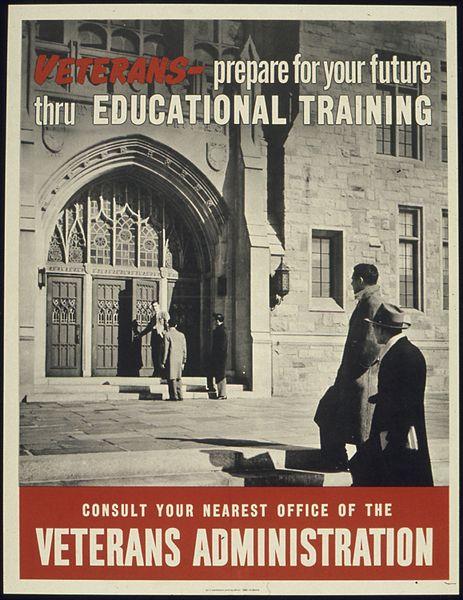
The government spurred middle-class prosperity with the GI Bill, which provided aid to white veterans for housing and education while staving off the sort of resentment caused by delaying benefits seen in the Bonus Army March of 1932. The GI Bill granted free tuition to veterans, triggering a huge expansion in higher education. In 1900, only 1/400 Americans went to college and only 6-7% graduated from high school. Today around 40% of Americans get some higher education or training, and 75% graduate from high school. This education growth probably would’ve occurred anyway as the economy grew more complex, but the GI Bill hastened the transition.
Optional Viewing & Reading:
U.S. Holocaust Museum, Smithsonian
Historians Put Truman On Trial, HNN
The Decision to Drop the Atomic Bomb, Truman Library
Stephen Allen, “The Catholic Church & the Holocaust,” Origins, 10.29.98
Theresa Machemer, “Newly Unsealed Vatican Archives Lay Out Evidence of Pope Pius XII’s Knowledge of the Holocaust,” Smithsonian, 5.20
The Atomic Bomb & the End of World War II: A Collection of Primary Sources, NSA @ GWU
Karl Compton, “If the Atomic Bomb Had Not Been Used: Was Japan Already Beaten Before the August, 1945 Bombings?” Atlantic (12.1946)
>> Truman’s Response to 1946 Atlantic Article
Bruce Hunt, “The Atomic Bombs & the End of World War II,” Not Even Past (9.20.11)
Robert James Maddox, “The Greatest Hoax in American History: Japan’s Alleged Willingness to Surrender During the Final Months of WWII,” History News Network (7.28.08)
From E-mc² to the Atomic Bomb (Einstein Online)
Peter Kuznick, “The Decision to Risk the Future: Harry Truman, the Atomic Bomb & the Apocalyptic Narrative,” Asia-Pacific Journal (7.3.2007)
Peter Van Buren, “We Thought Diplomacy Couldn’t End the War In the Pacific. But We Dropped the Bomb Before We Found Out For Sure,” History News Network (5.21.17)
Jeremy Kuzmarov & Roger Peace, “The Japanese Surrender in 1945 Is Still Poorly Understood,” History News Network (9.26.21)
Alex Wellerstein, “A Purely Military Target? Truman’s Changing Language About Hiroshima,” Restricted Data: The Nuclear Secrecy Blog (1.19.18)
Alex Wellerstein, “Did Japan Offer to Surrender Before Hiroshima (Part 1),” The Nuclear Secrecy Blog (5.2.22)
Alex Wellerstein, “Did Japan Offer to Surrender Before Hiroshima (Part 2),” The Nuclear Secrecy Blog (5.2.22)
Video:
The Fallen of World War II (Vimeo)
George Stevens, Paris Delivered (1944) YT 10:20
